


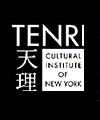 Tenri Cultural Institute
Tenri Cultural InstituteZelenka’s Dominion and Frailty features paintings from the last three-year Covid period that speak to the issues of poverty, power, discrimination and disenfranchisement. Generally speaking, Zelenka engages with the existential quandary and its empirical questions – who are we; what is the purpose of life; what is its meaning; what defines us as humans? Zelenka’s painting Colors and Black and White, 2021 demonstrates such a conundrum where a poverty-stricken homeless man sits on the ground amid countless objects from dispossessed migrants. The top part of his body is nude while the bottom portion is covered in the same grey and black striped drapery as the other four figures in the scene. The latter stand off to the left side and are shown receding in space within the collection of objects; the first holds a long piece of brown metal, another behind him clutches a bundle, the next in further recession balances a rather large container on his head, and the smallest one all the way in the back is situated on the diagonal horizon line. They are all studying piles of possessions on the ground; hats, bags, suitcases, carpets, shoes, bottles, a bed, a bureau all the accrued wealth displayed like a memento mori that reminds us of our mortality. Zelenka’s words resonate with this work “..we are all quite similar” he writes. “We want to live, to procreate, to protect our family, our system, we need to eat, and we will all die. Thus, we are a community of souls in a temporary existence. This means we all co-exist and are required to follow the rules of engagement in order to leave behind a meaningful legacy and to enjoy a peaceful co-existence for which respect is necessary.”
In his compositions Zelenka uses color imbued with symbolic significance “white implies silence, black darkness, red, a touch of sex and violence while blues are more peaceful as are the yellows.” Zelenka analyzes world power as he portrays the overt and covert differences between class structure and ethnic identity. He experiments to find the right balance in depicting his subjects but feels his calling is “to create a narrative of situations of human existence vs an individual’s own self.”
FOR MORE INFORMATION: Please contact Tenri Cultural Institute, 43A 13th Street, NY, NY. 10019 [email protected], or the curators Dr. Thalia Vrachopoulos at 646-344-9009, [email protected] or Elga Wimmer at [email protected], 646-515-4898.

October 1st – November 30, 2020.
When thinking about art and politics, one of the most influential and celebrated postwar German artists, Joseph Beuys, inevitably springs to mind. With his message of the revolutionary potential in art and the social sculpture, Beuys made clear that he wanted to bring art into politics, not the other way around. Serious, yet playful, his “Boxing Match for Direct Democracy” is a powerfully symbolic performance piece.
Artists in all aspects of the visual arts often depict the scurrilous, bizarre and surreal aspects of politics. In cinema, a telling example would be the filmmaker Mel Brooks, an American contemporary of Beuys, who pushed the envelope in parodying the Nazi Regime as a burlesque Broadway Comedy.
Utilizing humor in political critique has long been an effective tool for artists. Nevertheless, they risk being attacked and or rejected, when touching that third rail of politics and social critique. Each one of the artists chosen for this show has gone through that experience. In this exhibition, Julius Deutschbauer (Austria), Gala Knoerr (Spain), Liliana Porter (Argentina), Carolee Schneemann (US), Federico Solmi (Italy, US), Marina Vargas (Spain), Wolf Vostell (Germany/Spain) and Rodney Zelenka (Panama), address different social and political issues through their art.
Visual art, as in music and writing, when of a high caliber, is timeless, and that can be said of Carolee Schneemann’s work. In “Oil of Path and Five Vesper” the artist references a devastating oil spill from the 1990’s. Such global environmental disasters have occurred with disturbing regularity over the decades since; some 137 oil spills worldwide. If artists do not call attention to and thereby keep alive environmental awareness, all of the pledges made by governments and citizens will be forgotten until the next disaster strikes, and every day will be Groundhog Day.
“Vesper” has been the star cat in many works by Schneemann, such as in “Infinity Kisses” which draws on Egyptian mythology; the kiss by a lion /cat of eternal life. Now with both Vesper and the artist gone, the work has attained eternal status, combining the political and the private, the public and the intimate, the absurdity of the news/ fake news, with the poetic and the reclusive.
Julius Deutschbauer’s “Gesamtwerk” deals with politics in and around art. With 200 posters over 27 years, the artist uses a technique of rip and paste collages, as in “Europe, your dead have nothing to laugh at” (2017). The artist, in all of the posters the protagonist, holds Herman Schuerrer’s book of that title (1971). At the bottom of the poster the title of a series reads “Antirassismusvergnuegungspark “ (Anti-racism Amusement Park). The poster connects to a performance under the same title in German and English. The German text is read aloud by the artist, followed by the English translation read live by a second performer. Julius Deutschbauer created the museum library for the unread book in 1997. He is a performance artist, painter, and filmmaker. Recently he received a prize for culture by the Austrian county of Kärnten, which he proceeded to eat at the ceremony, after dipping it in beer. Deutschbauer examines social and political issues through posters for the public, with Interactive performances, and the humor of a Commedia dell’ arte character.
In a similar vein, another artist featured in this show, Federico Solmi, was banned from the art fair in Bologna for daring to portray the fictional Pope Urban the LXX in his work “The Evil Empire.” His Pope embraces the darkest tendencies of the 21st Century, indulging all of his vices and impulses to no end. There is some hope for the viewer, however, as he is punished and sent for repentance to what looks like Dante’s Inferno. Of course, in Italy, the Pope is still untouchable, even in art. Solmi’s perfect drawings depict despots and tyrants (see “The Loving Despots”), from past and present, as comic figures, akin to merry-go-round cartoonish characters in a comedy of the absurd. Much like Francisco de Goya, the cartoonish and exaggerated depiction of the social and political agenda is presented in perfectly executed drawings and paintings, adding more recently video paintings (as “The Machiavellian Ones”). Both artists, in their own way, employ extreme satire to critique the corruption of figures of power across cultural, financial, governmental and religious institutions. Solmi’s satirical aesthetic portrays a dystopian vision of our present-day society.
Rodney Zelenka’s stark and masterful depiction of the human body, reminiscent in certain visual aspects and subject matter of Leon Golub’s brutal paintings, which like him, depict the everyday man in violent situations. Zelenka (of European descent, working and living in Panama) presents the man from the street, addressing the homeless issue, in all its agony, but with great dignity. This is apparent in the work “Dos Grados más allá de la Locura” (Two Degrees beyond Madness) 1997. A man (a homeless, indigenous black man) sits in a makeshift shelter in a sea of starry images that look eerily like today’s thorny depiction of the coronavirus. He seems to be in a state beyond madness, wearing no clothes and sitting trapped inside a dark tunnel. Part of a series of paintings on the homeless issue, this work in particular symbolizes the time Zelenka lived through a horrendous military dictatorship in Panama (1968 – 1989). His figurative paintings are comprised of the allegorical with a timeless touch – from Renaissance to contemporary art – pointing out the seemingly never ending suppression of the lower class man/ woman in the course of history, regardless of promised political changes.
The dawn of the Internet age coincided with the coming of age of the millennial generation, conditioning our personal communication mechanisms and language with which we navigate multiple realities. The Internet has intensely permeated all aspects of our daily lives, and through widespread adoption of online social networking we have inadvertently been commoditized through the data we generate. Consequently, we observe the creation of reactionary socio-political movements birthed from the immediacy of a tweet or images that go viral. Both the Internet and social media, and the algorithm that transforms our online experience into an anesthetic monologue, offer a false sense of collectivity, generating cracks in the status quo of our real lives. One’s frustration and helplessness is now a very powerful weapon. Gala Knoerr’s “Alternative Facts I & II” explores through humor, how we can generate reflections that look at the associative nature within consumer culture, the capitalization of social movements and the representation of diversity in the media across the political spectrum with the language of the Internet.
There is a popular app that purports to teach kids how to draw, whereby a sweet voice guides them through a ten-minute tutorial, explaining, for example, that “a line has many directions” and how “a line is not to be repeated one on the top of the other, as it cannot move left or right.” This goes against the tendency of children to draw with repetitive, circular motions without thinking of the infinite directions a line can take. Before the kids could even pick up a pack of colored pencils and go wild, this disembodied voice tells them what a line cannot do. This is a precursor. Eventually Facebook will tell them what they cannot post, and YouTube will tell them what they cannot share. Ultimately, of course, they will learn by rote what not to think. On the first page of the website belonging to Argentinean-born, New York based Liliana Porter, we find a collection of small drawings, some of which evoke that soothing voice of the tutor: “A line has many directions.” Porter depicts a drawing collaged with a small photograph of a man who seems to have gotten stuck at the end of his lines (The Traveler, 1999) and is looking for what remains in the space — a space formed by the ruled page of an old exercise book, its lines now faded by time. This drawing with its minimalist marks and diminutive personage is like the essence of how the spectator should move closer in order to reach the center of an installation, opening one’s eyes to the possibilities of the line drawn by a free hand. Yet since he is the one who draws these lines, he must look in many directions to locate the multiplicity of possible directions to pursue, as when a traveler links the disparate routes of a journey.
Marina Vargas, born 1980 in Granada, is one of the most powerful and promising artists of her generation, a proverbial force of nature. For Vargas, drawing serves as underpinning to all of the disciplines she works in — sculpture, installation, painting, photography and performance. Her work often references the Christian and Baroque substrata of her native Andalusia, as well as the processes of syncretism that, either from the religion or from the arts, have put different cultures in contact, regardless of geographical and historical distances.
Metaphorically, drawing these distant ends, serving as an epistemological mechanism to delve into the knowledge of human nature. But more specifically, drawing is both the point of departure and the final step in the creative process. (Source reference: “The Drawing of the Life to Come” by Afonso Molina).
Finally, there is Wolf Vostell who commemorates pivotal life experiences from a personal narrative, in an offbeat photo collage. Born in Germany, Vostell spent much of this life in Extremadura — on the border with Portugal, where the famous pata negra (blackfoot) pigs roam the holm oak forests, eating the acorns that sustain their flesh. In one erotic spectacle, we see a woman dressed as a bull confronting death (or women are dressed as bulls confronting death). Vostell is in his element here — an often bizarre, whimsical body of work.
The artists presented in “Everything is Art, Everything is Politics” explore the heightened power of art, when it informs and shapes political change, rather than the other way around. The crucial difference here cannot be overstated. It is a kind of Poetic Terrorism (Hakim Bey) that causes onlookers to stop in their tracks and widen their horizon. According to the originator of the expression PT: “If it does not change someone’s life, (aside from the artist) it fails.”

February 25 – March 15, 2020.
Opening Reception: Thursday, February 27 6-8 PM
Brunch during Armory Show on Saturday, March 7, 2020 1-4 PM
Gallery hours: Tues - Sat 12PM - 6PM
Sobin Park’s positive manifestation of the Eastern dragon as a fortuitous and royal sign is altogether different than most western guises of the dragon viewed as monster that brings destruction in its wake. In the east the creature holds positive, life affirming, divine significance moreover, in Park’s iconography his inclusion and meaning are further enriched.
Although varying morphologically according to historical period and geographical area, generally, dragons have been represented with scaly skin, long teeth and a serpentine body. In the east, this composite animal is seen as a wise and angelic beloved creature to which many a temple has been dedicated. Dragon legends have recently been used by many to express shifting social attitudes within modern civilization as well as a pluralist position towards ethnic inclusion. Park uses this icon to convey not only the marriage between the physical and divine aspects of life but also the manifest destiny arising from such a union. Park’s maidens are beautiful usually shown entwined within the dragon’s embrace, sometimes in the midst of transforming from dragon to female or vice versa. This is evident in the scales that populate the female’s lower regions but also in the almost human tenderness of her dragons. Park shows these two figures intimately inter-relating, and totally absorbed in each other’s form that may even be described in the Surrealist sense as ‘convulsive beauty.’
Park employs a work-intensive methodology using pencils on extremely large formats of paper and canvas that span the gallery walls undulating and unfurling themselves horizontally akin to the dragon’s forms. For this exhibit Park exhibits several of her monumental canvasses but also several smaller vertical pieces.
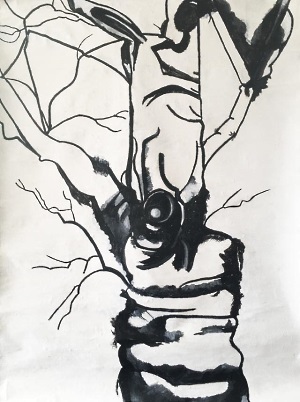
January 9 – February 1, 2020
Opening Reception: Thursday, January 9 6-8 PM
Gallery hours: Tues - Sat 12PM - 6PM
Elga Wimmer PCC is pleased to present a one-person show by Mary Hrbacek, featuring new work consisting of drawings, paintings and painted drawings. Ms Hrbacek's signature theme focuses on her unique depiction of trees, as they relate to the "human form in nature," inhabiting the margin between figuration and abstraction. Her work calls into question the status quo in society that tends to view nature as a separate entity to be exploited instead of recognizing the inherent interconnectedness of living things.
This fascination with nature and transmuted natural forms has been explored by other artists in the past, most notably Dorothea Tanning and Georgia O'Keeffe. While Tanning took a more mythological approach, Georgia O'Keeffe's Cow's Skull has a direct link to Hrbacek's "Enclosed Torso." The latter depicts a "body" of a tree that is fenced in, as if preserved or protected. Hrbacek expresses these perimeters by situating her trees within the simple architectural boundaries of cafes or restaurants. She views their setting as being "embraced," within limits, which parallels her life experience today.
The mythological themes of transformation in Hrbacek's works, anchored in stories suffused with feelings of regeneration by Roman poet Ovid, suggest meanings such as the universal thirst for redemption. The Pefka serve as mute witnesses to the influx of displaced persons who came to Greece following increased international conflicts. The trees serve as symbols of resistance in the face of climate change and political indifference.
The much more austere charcoal drawings on paper are made of compressed tree bark, that recalls muscles and flesh, the powerful forces of nature. Here too, vertical lines encase parts of the tree which interact with contrasting zones of shadow and light. The lines zoom in on twisted sections that seem to burst out of the frame.
The show culminates with the larger painted drawings, which offer a more abstract depiction of the tree. Ms Hrbacek applies a light hand across the canvas, and even though this work is acrylic on canvas, there is an element of drawing in play. The "bodies" of the trees seem ephemeral, shadow-like, and play beautifully with the light within a black and white ambience.
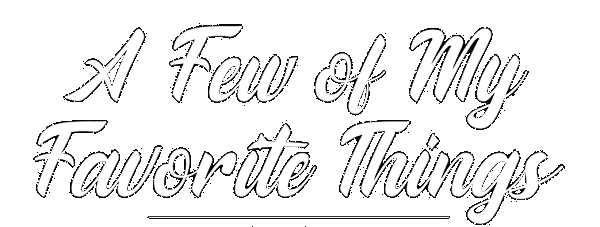
December 7 – 21, 2019
Opening Reception: Saturday, December 7 2-5 PM
5pm performance of augmented reality by Richard Humann on the High Line above 26th Street
View pdf of the New York Times' article relating to Richard Humann's augmented reality work

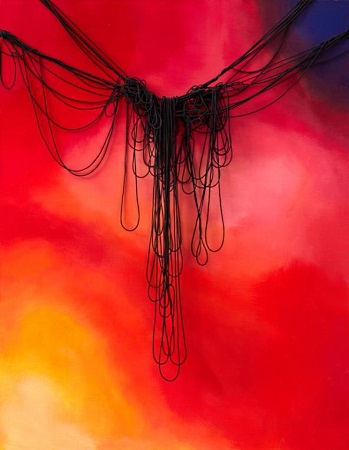 Soon-yeal Yang, Scarlet gomujul 3, acrylic on canvas + gomujul, 2019.
|
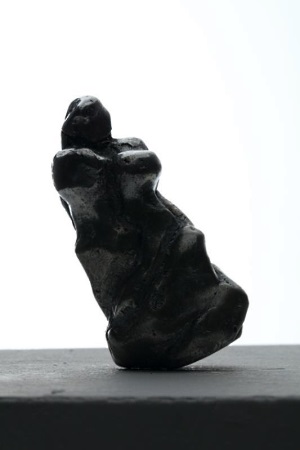 Soon-yeal Yang, Homo Sapiens 13, aluminum, 2019.
|
October 30 – November 9, 2019
Opening reception Wednesday, October 30, 6-8 PM
Gallery hours: Tues - Sat 12PM - 6PM
Soon-yeal Yang’s centerpiece, for the past years, has been the Ottogi sculpture. A stylized version of the female body, the rounded form, much like a roly-poly toy, bounces back, when pushed off balance. The artist regards the Ottogi as an embodiment of “the female,” motherhood, Mother Earth, the root of all beings, tranquility and warmth – much needed sentiments in a time of turmoil.
Her series of sculptures titled “Homo Sapiens” presenting a much more abstract form of the human body, that encompasses both male and female, leads up to Ottogi, the “goddess,” in the center of the exhibition. The artist has created these tabletop sculptures (aluminum, 4 – 8 inches high) for the past 15 years. Their abstract forms recall various precedents --- Rodin’s “Balzac,” Brancusi’s smooth shapes, even ancient Chinese scholar’s rocks. In Asia these stones are respected for their beauty, which is artistically nourishing, and for their upright, refined and persevering character. Because of this affinity, scholar’s rocks are addressed in terms of respect, such as “Brother,” “Friend” and “Master.” In the case of Soon-yeal Yang’s “Homo Sapiens,” the sculptures take on a similar character, and in the artist’s view become “Mother,” and “Mother Earth,” mirroring the philosophical concept of harmony between humankind and nature.
The paintings in the series “Scarlet Gomujul” are made of acrylic on canvas and gomujul (thread, rubber wire). In the artist’s words, “Thread in my work depicts relationships between people, often complicated and difficult, given to background and individual personalities. The characteristic of the added rubber wire underlines that sentiment. To make our lives harmonious and peaceful, we need to be flexible like rubber wire.”
Anchored in Asian spirituality, Soon-yeal Young reaches out to an international audience by symbolizing sentiments of the female (Ottogi) as a source for establishing harmony and peace in the world, already achieving that in visual terms through her highly inspiring art.
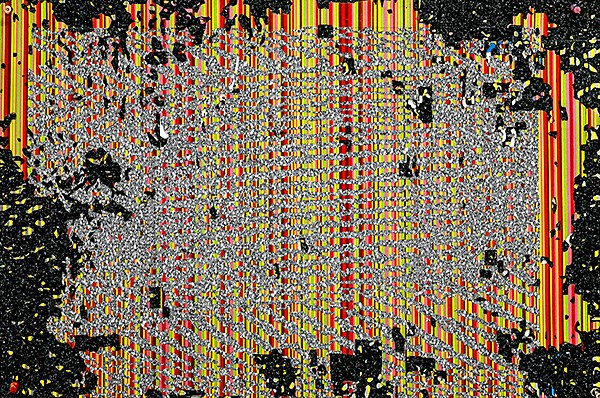
September 27 – October 19, 2019
Opening reception Friday, September 27, 6-8 PM
Gallery hours: Tues - Sat 12PM - 6PM
ELGA WIMMER PCC is pleased to present “Rumor”, an exhibition of the Brazilian contemporary artist Luiz D’Orey. The exhibition presents D’Orey’s new series of paintings, a video and a sound installation.
“Rumor” is an investigation on the invasion of public opinion into a space that was once exclusive to big broadcasting companies. In his series of paintings entitled Cascade — as a reference to the juxtaposition of windows on a computer interface — D’Orey combines the techniques of spray painting, laser printing and laser cutting to create visual equivalents to the flow of information in social media. The video and sound installation further explore the manipulation of appropriated content as masses of agglomerated text and noise.
“Cascade” is a reference of superposition of images on a computer interface or on screens in general. “It’s an investigation on the flow of information.” In his paintings and interventions, Luiz investigates the processes of circulation of information and its systems in the urban and digital context. The new series refer to both physical space and the digital space of social media. “The pixel and the image as a whole and the superposition of texts and images to the point it becomes a sort of ‘noise’ - an abstraction,” a 21st Century Graffiti. Luiz D’Orey, in an earlier series, used torn images of billboard advertising to create his paintings.
Luiz d’Orey was born in 1993 in Rio de Janeiro and moved to New York in 2012. He received his BFA degree from the School of Visual Arts in 2016. During the four years attending SVA he was granted the 727 Award (2016), the Sillas H Rhodes Award (2016), the Gilbert Stone Scholarship (2015), and in 2016 was also chosen to represent the institution at Pulse Art Fair in Miami. The artist has worked as an assistant for the two prominent Brazilian artists Carlos Vergara and Raul Mourão. D’Orey’s paintings have been shown in group shows and fairs in the US, Europe and Brazil. His first solo show Quase Plano (2017), took place in Rio de Janeiro, Brazil, at Mercedes Viegas Gallery, and was followed by the solos Espaço Comum (2018) at Dotart Gallery in Belo Horizonte, Brazil, and Recent Ruins (2018) at Gitler & Gallery in New York City. In 2018 his short film Tapume (2018), co-produced with Hugo Faraco, was nominated to the DOC NYC film festival. In 2019 d’Orey was nominated for the PIPA prize in Brazil. His work is also part of the Pipa Institute collection in Rio de Janeiro, Brazil.
July 10 – August 3, 2019
Summer hours: Tuesday - Friday 12 to 6 pm or by appointment
Private Preview: Wednesday, July 10 - 5 to 7 pm
Opening Reception: Thursday, July 11 - 6 to 8 pm
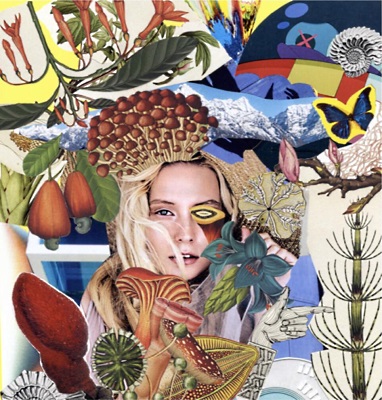 Olga Ozerskaya Girls Chaos, 2018, mixed media and inkjet print
|
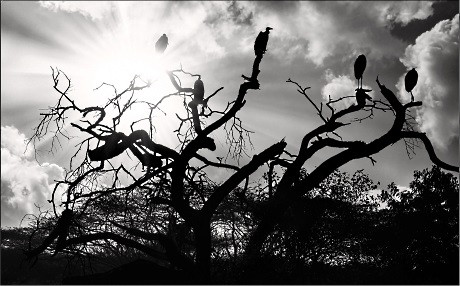 Anna Rakhmangulova Étude 2, 2018, digital print photograph
|
Olga Ozerskaya’s work focuses on storytelling, thus provoking independent thought. Her collages, intricate and diaristic, recall the “female flower landscape power” of Nikki de St. Phalle. At first sight, brimming with decorative energy and light, they exude a femininity, as well as a playfulness, via a strong visual vocabulary. Consciously manipulating images through collage, the artist detaches them from their stereotypical association with advertisements and branded identities.
Olga Ozerskaya (born 1984 in Moscow, Russia, attended art school at the Tretyakov Gallery and graduated from Moscow State University) draws from both Constructivism and her experience in design and fashion. Like Sonia Delaunay who played with patterns and supraposition, of “cut-outs”. Ozerskaya is noted for her strong colors and geometric shapes.
Mixing pop, fashion, and advertising images with her own iconographies, Olga Ozerskaya achieves a surrealist expression with a unique contemporary twist.
Anna Rakhmangulova (born 1978 Moscow, graduated from Moscow State University’s Fine Art Faculty) captures landscape with sharp contrasting black and white images.
Rakhmangulova invites us to rediscover our lost connection with nature through powerful visions of animals and remote landscapes made with a sensitive and impeccable photographic style. She uses light as the protagonist of the dramatic story told in each image, creating poetic yet disturbing compositions, in a manner that resembles Ansel Adams’ best-known images. Her panoramic views have the same monumentality and sense of transcendence, as she is very close to his shape focus approach.
Her images equally evoke Sebastiao Salgado in his interest in showing remote areas of the planet, presenting the epic reality of animals, the inhabitants of magnificent scenarios.
Rakhmangulova reveals the force and beauty of nature with her highly contrasted figures and her strongly modeled cloudy skies.
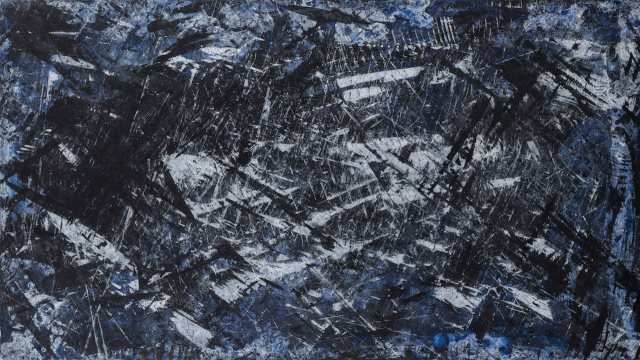
June 19 – July 2, 2019
Opening reception: Thursday, June 20 - 6 to 8pm
Elga Wimmer PCC is pleased to present Qian Wu’s solo exhibition.
In Qian Wu’s paintings (oil, acrylic, ink, watercolor), layers of light blue, black and white cover an abstracted image that resembles architecture or a mountain range. The powerful strokes obscure what seems to be a more picturesque scenery, almost like a fuzzy out of focus screen. Maintaining the elegance of traditional Chinese ink painting, the artist is simultaneously influenced by Western abstract practices. Some of the work recalls Franz Kline and Hans Hartung, but Wu’s rich compositions with bold rhythms and contrasting layers of black and white, definitely convey a very contemporary way of expressing abstraction.
Qian Wu was born in the City of Xiamen, Fujian Province, China. After graduating from New York University with a major in social and cultural analysis, he earned a master's degree from the Weatherhead East Asian Institute at Columbia University. From 2012 to 2015, he studied at the Art Students League of New York. In 2016, Qian Wu’s first solo was held at the Chinese American Arts Council - the exhibition “Wandering in the Crossroads” is the artist’s 2nd solo show in New York.
January 17 – March 10, 2019
Opening Reception: Thursday, January 24, 6 to 8pm
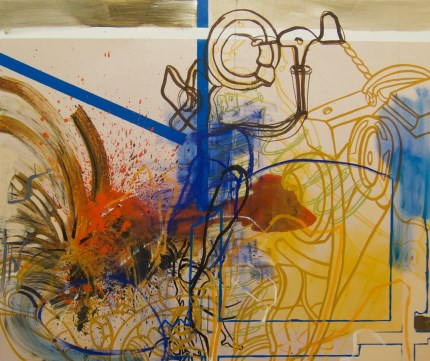 Lydia Dona, Matter Above Memory, 2018,
Oil, acrylic, enamel paint and pigment on canvas, 60 x 72 in |
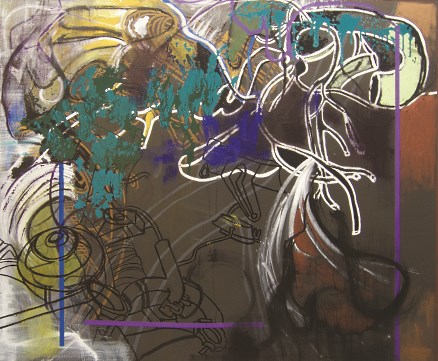 Lydia Dona, Bold Assessments, 2018,
Oil, acrylic, enamel sign paint on canvas, 60 x 72 in |
Lydia Dona
In Lydia Dona’s work, everything takes on a visual form — the city scene, neon lights, brass colors,
movements of machines, even noises —all of these disparate elements are transposed from chaos to
composition. Dona’s newest paintings “Bold Assessments” and ”Matter Above Memory”, with their
unique hybrid of various media (oil, Acrylic and enamel sign paint, pigment) equally reflect city life as
billboards, video projections, tops of sky scrapers, and the churning of construction and destruction.
As an American artist born in Romania, Dona draws on her immediate surroundings – the urban environment, as well as early century car manuals, Marcel Duchamp’s early work, Deleuze’s notion of people as “desiring machines” (as quoted by Raphael Rubinstein in “Lydia Dona: Zones of Luminous Conflicts,” 2007), biological organs, environmental shifts, medical information, architecture and cinema. Most elements in Dona’s paintings are developed from observations in her personal life, and also from her reactions to significant global issues and events.
In the artist’s words: “The core of my work was always this battle, I think, some sort of battle between this abstraction and a narration within the abstraction. There was always narration without wanting to be narrative, and an abstraction without wanting to be formal, and the combination of this that would always have a plot... And I think that that plot... in which there is a relationship between body and environment, was always there."
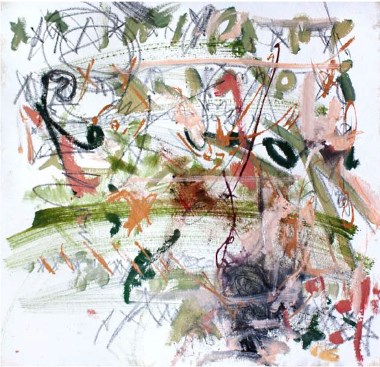 Carmen Neely, Putting in the work (a third time), 2018,
Graphite, charcoal and oil on canvas, 34 x 34 in |
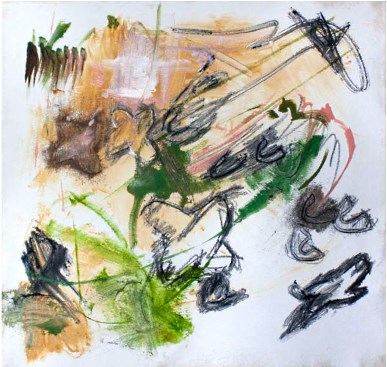 Carmen Neely, Putting in the work, 2018,
Graphite, charcoal and oil on canvas, 34 x 34 in |
Carmen Neely
Carmen Neely captures select moments of romantic nostalgia and confusion in these works
that utilize painting and found materials, imbued with keen societal observations on the
intersection of love and loss. She revisits conversations, life events and tactile items in the
process of creating. As such, the artist weaves her interpersonal relationships through the
works reflecting on and relishing the past.
Carmen Neely, who received her MFA from the University of North Carolina at Greensboro two years ago, demonstrates a facility with many types of marks, from obsessively reworked scratchy patches,
to wide-brushed circular sweeps to delicate contours, to confident graffiti like zigzags, that evoke a
host of art historical predecessors. Neely’s abstract works are relatable and even openly invite the
viewer to project their own interpretation. The artist bends abstraction into a means of storytelling.
- Elizabeth Buhe
From Art in America
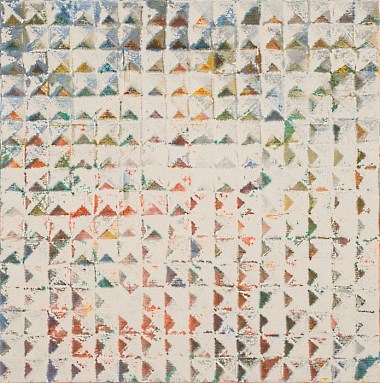 Lynne Golob Gelfman, thru2.b, 2014, acrylic on canvas, 48 x 48 in
|
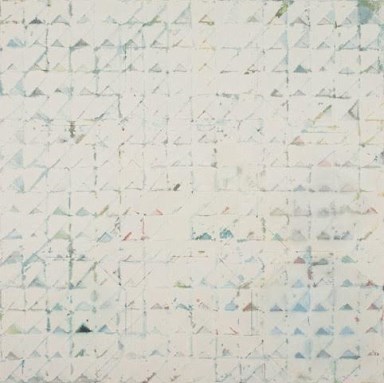 Lynne Golob Gelfman, thru3.4, 2015, acrylic on canvas, 48 x 48 in
|
Lynne Golob Gelfman
Lynne Golob Gelfman plays with surfaces in diverse ways; sometimes staining the canvas, other
times creating reflections in gold and silver, or channeling drips of paint in angular lines down the front
of the composition. In this regard, Gelfman builds on the movement of American Abstract
Expressionism, where, as the French artist group Supports/Surfaces in the 1960’s and 1970’s, she
focuses on the materials of the paintings. This art movement redefined painting in the sense of
creating architectural type sculptures of what may have been painted on the canvas. Gelfman is also
influenced by indigenous textile and basket-weaving techniques, from her years in Columbia.
From Grids: A Selection of paintings by Lynne Golub Gelfman, Perez Art Museum, Miami, through April 21, 2019
The thru series additionally recalls weaving patterns, through its use of repeating triangle and square forms. She began this series in the 1970s but has returned to it in recent years, producing works at varying scales and formats.
The artist’s alterations of the grid show this geometric and rational form as quite vulnerable, as easily susceptible to dissolution and manipulation. She has described this aspect of her work as referencing the rapid disintegrations and manipulations of values and ethics within our contemporary society.
We thank Jane Lombard Gallery for facilitating a collaboration with Carmen Neely’s art, and Marisa Newman Projects for her generous support in showing Lynne Golob Gelfman’s work.
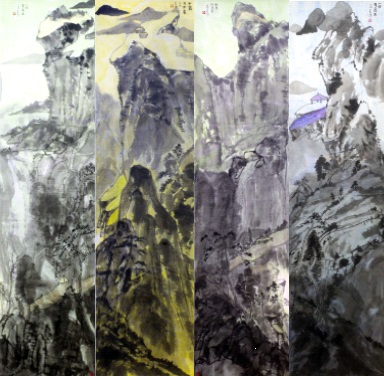
November 30 – December 14, 2018
Opening reception: Friday, November 30 - 6 to 8pm
As a rich old art form with over a thousand years of history, Chinese ink painting has always been concerned with carrying its own “tradition” and preserving its complete traditional ecology. However, from another point of view, this is also a negative restraint. Under the heavy influence of modern Western art, many Chinese painters have begun to be dissatisfied with the stagnation of strictly following tradition and instead are experimenting in various ways. Especially in the last two decades, Chinese ink painting has seen a promising wave of change and innovation, hinting at a successful future with more to come.
With this new prosperity comes new questions about maintaining balance between traditional brush and ink and contemporary types of artistic exploration, especially considering how many so-called new Chinese paintings now only have tenuous connections to their original heritage. This recent ambiguity begs the question: How much tradition does an ink painting require to still be called "Chinese"?
Liu Chunbing’s “A Walk in the Clouds” exhibition from Hubei, China, brings his perspective on these issues to New York. The modernization of pen and ink language is a consistent theme explored in Liu’s work. He employs traditional ink skills and stroke applications, maintaining the elegance of Chinese painting while simultaneously breaking from traditional Chinese patterns through the composition and subjects of his pieces. Blending traditional methods and the multi-dimensional narrative approach of Western modern art, traces of surrealist influence can be felt within Liu’s art. There are also unique features in Liu’s use of color: in between the conventionally harmonious blacks and whites of ink and paper emerge sudden glimpses of bold color. In particular, his paintings of figures transport current-day social snapshots into historical settings with a time travel-esque flair, culminating in a surreal visual feast.
Liu Chunbing's works have achieved an excellent balance between “tradition” and “breakthrough,” telling a story spanning time, space, and culture in a painting language familiar to audiences both Western and Eastern. His works undoubtedly provide an excellent model for other artists who are exploring Chinese ink today; through these works, he establishes his own powerful interpretation of how Chinese painting should continue to move forward.
作为一个有上千年历史的画种,中国画一直讲究对“传统”的传承,这使中国画在今日仍然保存着其完整的传统生态。但是从另外角度来看也是一种固守不前的负面束缚,特别是在近代西方艺术影响下,很多中国画画家开始不满意仅仅驻足于传统,开始了从各个方面的新尝试和新实验。于是在最近的20年里我们看到中国画出现了大量的变革与创新,呈现一片繁荣。 繁荣过后很多人又陷入思考,在传统的笔墨与各种新型的艺术探索之间应该如何保持一种平衡。因为很多所谓新派中国画已经无法分辨它们的中国血统。到底该有多少传统血缘才能被称为“中国画”呢? 来自中国湖北的艺术家刘春冰的“云中行”展览为纽约的观众带来了他对这些问题的思考。笔墨语言的现代化一直是刘春冰探索的方向,所以在他的作品里可以看见非常传统的丰富笔墨和对线条的多种应用,仍然保持了中国画优雅的特质。但是另一方面在构图和主题上他打破了传统国画的格局,融合了传统绘画的散点造境和西方艺术里的多维度叙事方法,仿佛看见了超现实主义的影子。在色彩的运用上也有独到之处,在传统黑白间突见惊鸿一瞥,既有突破传统之惊喜,也有蕴藏在传统中之和谐。特别是以人物为主题的系列更将当下的场景以时空交错的方式带入历史,是一场视觉上的超现实的华丽盛宴。 刘春冰作品的作品在“传统”与“突破”间达到了极好的平衡,以东西观众都熟悉的绘画语言讲述了一个跨越时空和文化的故事。他的作品无疑给当今为中国画而探索的其他艺术家提供了极好的范本,也为中国画真正走向世界而写下了自己用力的注释。
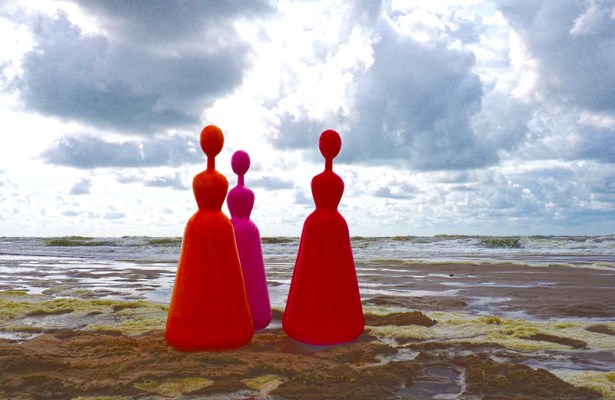
November 1 – November 21, 2018
Reception: Thursday, Nov. 8, 2-4 pm / 6-8 pm
Artist Talk with Robert C. Morgan
In her exhibition, Eternal Rhapsody, Korean artist Yang Soon-yeal presents her recent painting, sculpture, and media installation. Despite the various visual mediums in which she works, the fundamental core of her show is a sculpture of a standing female figure. This highly simplified form with its rounded shape omits details of the human body. The sculpture consists of a weight inside the bottom hemisphere that it will make it return to an upright position when tilted to one side. What Yang calls Ottogi (오똑이) in Korean might be translated into English to mean a roly-poly toy or a tumbler doll.
The round-bottomed toy generally implies its ability to have success, overcome hardship, and recover from misfortune. While Yang's Ottogi may have the appearance of a tumbler doll, the symbolic image in her artwork has a more sophisticated meaning. Yang presents the sculpture as a symbolic image of Motherhood that holds a continuing grace and heightened spiritual understanding. The image of the Ottogi has naturally emerged in her work. YS Museum of Art (2008 -2010), a magnificent painting that presents an ideal world of a woman who is painted without arms. In contrast to the negative point of view, she wanted the figure to represent the more optimistic view of women who once worked hard and now enjoy their relaxation. Another image is from Homo Sapiens (2006-2013) in which she composed hundreds of small-size human figures casted in stainless steel. The two works of Homo Sapiens and YS Museum of Art are combined together and transmitted a stunned image, Ottogi. The visual character has been modified in a few times and was finalized as a refined image of the human body. While the work remarks on the role of woman and mother in relation to everyday life, Ottogi as a symbolic image of Motherhood pursues the profound question of human existence and leads us to feel the enteral love like the world of galaxies.
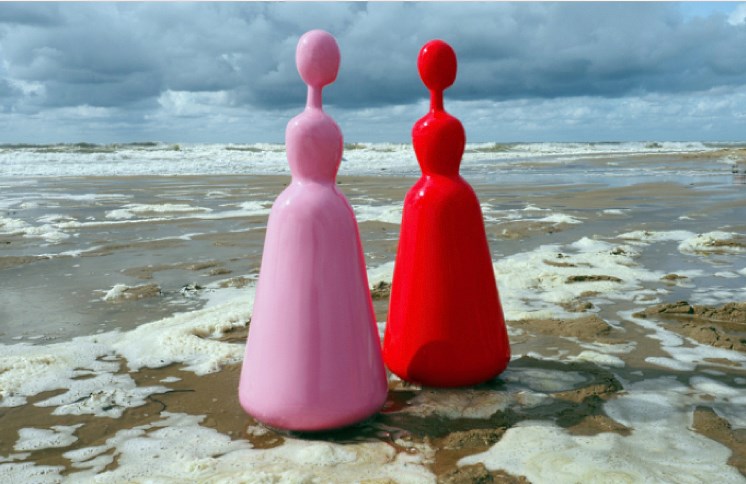
Yang Soon-yeal is a painter, sculptor, performer, and multimedia artist living in Seoul and Andong, South Korea. Yang has worked enthusiastically with all her heart and soul. The source of her work is deeply connected with her poetic sensitivity and insightful thoughts, which she implements in her art. Her show at the POSCO Gallery (2014) and the Gaekju Literary Space (2015) allow Yang’s liberation in her creative process as a record of the artist’s selfdriven purification. In addition, her artist’s career has expanded internationally. In an important lecture at the Art Gallery of the University of Missouri, Yang emphasized the different roots in her work by distinguishing the Oriental spirit from that of the Western world. Yang’s remarkable career continues to reinvent itself. This clearly became distinct in her exhibitions at the Hamelhuis in Gorinchem (2016), the Galerie Des Ami in Woudrichem (2017), and Kunstuitleen Alkmar (2017), all shown in various spaces in the Netherlands.
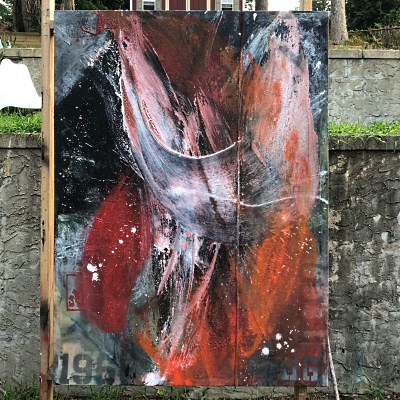
September 15 – October 13, 2018
Opening Reception: Thursday, September 20th - 6 to 8pm
Elga Wimmer PCC is pleased to present James Greco’s first solo show with the gallery, consisting of new painting and sculpture.
James Greco is a Brooklyn- based painter and sculptor who consistently explores improvisational mark-making, thus generating a form of narrative abstraction. The work flows purely, without emotional or intellectual constructs or concepts, as the marks lead to the discovery of a picture that lies between the gestural and the referential.
Greco states "a painting should reflect the human condition and a whole life without being didactic. There should be everything in a painting - a whole life - while saying absolutely nothing." The sculptures in this exhibition are created with the same intention. Greco’s earlier work had a stark, black—and—white, almost calligraphic quality reminiscent of Franz Klein. His series of Tarp paintings still carry that quality. But, now the bold gestures and strong colors of his recent oil paintings recall Abstract Expressionism. Greco has expressed his admiration for artists as diverse as Barnet Newman and Georg Baselitz. He uses traditional oil paints, epoxy resins, house paints and other mixed mediums to achieve his abstract variations, which range from small works on paper to large-scale paintings.
James Greco’s thoughts about his new works:
"This work is made with minimal thought, will or introspection. It is my intention that the viewer should somehow feel the physicality that is impressed upon each piece. My aim always is to remove my mind as much as possible from the process of creating so as to convey the freedom and vitality I experience making the work, thereby conveying this energy to the viewer."
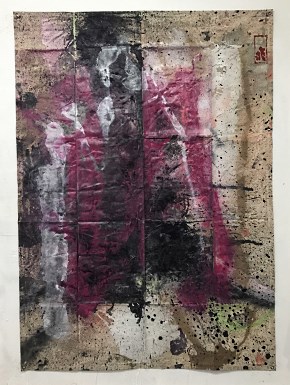 Tarp painting 14, 5 x 7 ft spray enamel on canvas tarp
|
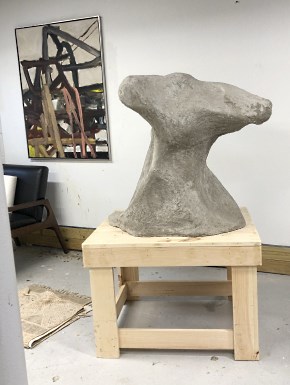 Audrey and the Praying Mantis, 2013, 30 x 40 in, oil and acrylic on canvas framed in aluminum
Golan, 2018, variable dimensions, wood, plaster, steel, concrete and structolite |
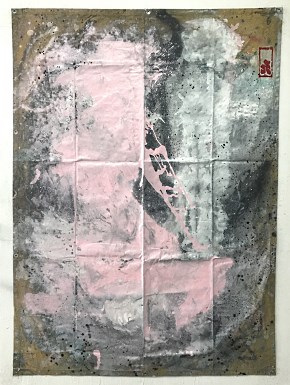 Tarp painting 14, 5 x 7 ft spray enamel on canvas tarp
|
James Greco’s work is represented in following collections:
Stella Tower NYC, DBI projects NYC, Museum of contemporary art Tucson, Ritz Carlton DC, ARO residential NYC.
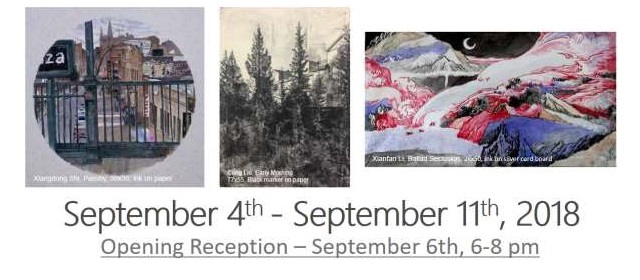
September 4 – September 11, 2018
Opening reception: Thursday, September 6 - 6 to 8pm
Elga Wimmer PCC is pleased to present curator Chenlin Cai's exhibition "Drift - Float:"
I lived in Beijing for eleven years before coming to the United States four years ago. At the time in Beijing I was a “Beipiao”, a vagabond in Northern China, and now have transformed to become a New York traveler. Fifteen years ago, I was a young artist searching for my ideals, and fifteen years now, still the same artist and idealist challenged to uphold my values and dreams. My years of growing up have been the era of newfangled transformations in China. One such development is the great migration of our population, when countless young people, with me as one, have left our old but cozy hometown to explore in big cities and then international cultures in pursuit of our careers. Our generation bears a stressful individuality dealing with live's anxiety and lack of identity, exactly as in “drift-float” that captures this stage of rootlessness, that best describes us as foreign artists living in our new yet alien “hometowns”. This exhibit has gathered ten artists from China, Europe and the United States, all living away from their hometowns. Each artist has his or her own daily environment, unique value systems and expressions and has shared his or her nostalgia, anxiety and response to the unknown.
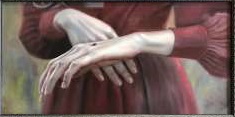
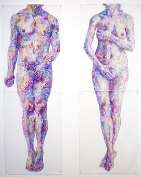
 Minyu Chen, Inferno's Door, Oil
Minyu Chen, Inferno's Door, OilXiangdong Shi focused on his first reflection over living in this country, both the order and disorder of Manhattan and Flushing streets, like testimonial records in a silent documentary film.
Cong Liu used his black markers to depict certain alien moods in familiarized situations, as records of lives overlooked, to form his sharp narrative viewpoints.
Xianfan Li's painting shows that the traditional Chinese mountain-river landscape has gradually been engulfed by incoming cities, with the sense of nativity that can no longer be restored.
Minyu Chen's series of Classic of Mountain and Sea (compiled c. 200 BC), through the use of ambiguous grey hues and images, gives new interpretations of the rare beasts described in the book.
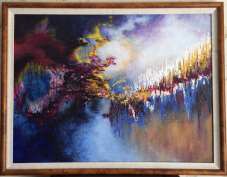
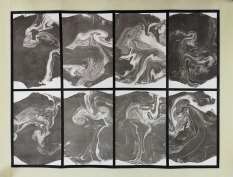 Shenghui Lin, Soul Dance in the Dark,
Shenghui Lin, Soul Dance in the Dark,Chenlin Cai uses traditional oil media to imitate cell formation through transparent materials. Through the microscopic visibility, he regroups human physiological formation and forms macro images of stature.
Yuntian Xie portrayed the expansion of the new from the old demarcates China's forever changing cities, with such speedy paces that make people hard to cope with.
Shenghui Lin uses his candid camera to capture Beijing’s once trendy Heiqiao Art District after its demolition and its pathetic mood.
Bei Lyu employs abstract landscape to tell a kind of dream-related mood. Illusion is a mirror and re-creation of the subconscious mindset based on real life.
 Michelle Zhuomin Cai Sun, Where am I?, oil on canvas, 4 x 4 ft, 2016
Michelle Zhuomin Cai Sun, Where am I?, oil on canvas, 4 x 4 ft, 2016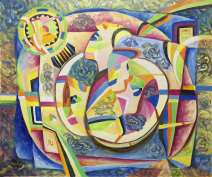 Yali Liao, Survival of the Fittest, oil
Yali Liao, Survival of the Fittest, oilYali Liao uses Chinese ink, through an abstract artistic style, together with vibrant colors and geometrical forms, to narrate an ordinary story creating a new visual image.
Michelle Zhuomin Cai Sun resorts to the paleo-floral fossils to capture the first flowers of the world, back to the Cretaceous period right after the Jurassic era.
June 27 – July 27, 2018
Opening Reception: Wednesday, June 27 - 6 to 8 pm
Summer hours- July: Tuesday – Friday 12-6pm or by appointment
ELGA WIMMER GALLERY is pleased to present “Three - Some – Thing ”, an exhibition of three contemporary visual artists: Jonny Detiger, Nevil Dwek and Beatrice Pediconi. The exhibition presents selected works from the three artists in a visual treat of photography, painting, sculpture and sound.
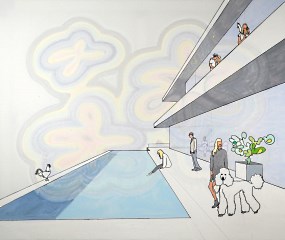 Jonny Detiger Poodle Pool
52 x 66 Acrylic, Marker, oil pastel on canvas |
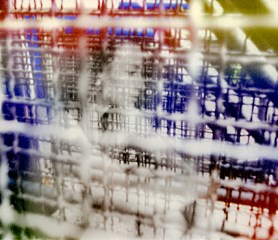 Nevil Dwek Away
UV printing on aluminum, Edition of 3, 40 x 50 |
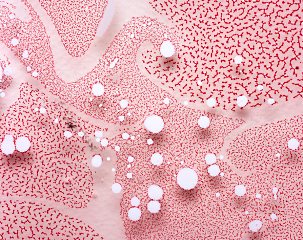 Beatrice Pediconi Alien Q
Courtesy sepiaEYE, Archival pigment print on Hahnemuhle barita paper of oil paint on water |
April 12 – May 5, 2018
Opening Reception: Thursday, April 12 - 6 to 8 pm
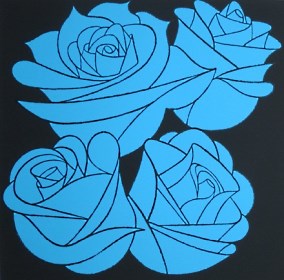
|

|
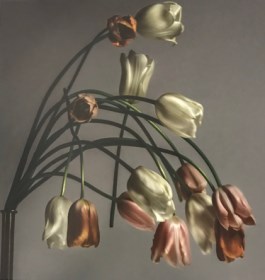
|
“Like the lily, That once was mistress of the field and flourish'd, I'll hang my head and perish.” (Shakespeare, Henry VIII)
Flowers are a beautiful and powerful symbol of life across the ages, and when the petals fall off the rose, or the lilies decay, they also have come to represent peace in the afterlife—every civilization & culture in human history has derived different meanings from different flowers, according to their mysterious rhythms. Perfumers who create scents make sure there is a note of decay to startle the senses: always a reminder that where is birth, there is death.
Duality held side by side is the matter of most things. The astonishing resilience of our nature is matched by the extraordinary fragility of our lives. Much of the complexity of our human trajectories defines itself within these two boundaries, one pulling toward life, one flirting with death (Barbara Stehle on Inma Barrero)
SPECIAL THANKS TO JULIE PANEBIANCO
SPONSORED BY SEA GRAPE WINE SHOP, 516 Hudson St., 212-463-7688
MICHELE MACK FINE ART
michelemackfineart.com
[email protected]
917-453-2642
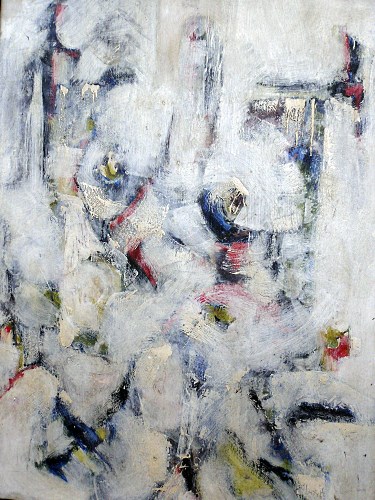
Curated by Roxane West and Elga Wimmer
March 8 – April 5, 2018
Opening Reception: Thursday, March 8, 6:00-8:00 pm
Shirley West (1928 - 2010), was a painter and sculptor, originated from Texas, who lived in Tribeca, New York, for most of her artistic life. One of her teachers was Max Beckmann, who, in the 1950’s, invited her to study with him at the University of Colorado, Boulder. West had her first solo show of drawings and paintings at the Museum of Modern Art in Miami in 1961.Throughout the ’60’s and ’70’s, Ms. West was active in the Art Students League in New York. Between 1968 and the early ’70’s, she built three large concrete outdoor sculptures that were constructed and remain on permanent display in Gainesville and Micanopy, Florida. A late highlight of Shirley West’s career was her solo show “Discovery: A Retrospective” in October and November of 2009 at the Chelsea Art Museum, New York.
The current show, “West by West” features paintings and sculpture dating from the 1950’s to 2005. West’s early paintings are reminiscent of Leger, and Picasso, yet have a distinctive style all their own. Two large female portraits in earthy colors (1950’s) demonstrate the latter. In some of the still life paintings from the mid ’50’s, we see the influence of Cubism and Morandi. This small survey of West’s work shows her to have been a strong proponent of figurative expressiveness, as well as an abstract sculptor of considerable achievement. Her welded and engraved rocks, resembling a diary in stone, are pure visual poetry. Some evok"Shirley West is both an explorer and a traditionalist. Within the confines of her style, we can see someone dedicated to the pursuit of a larger sensibility, in both the dimensions of the work, and the size of the ambition behind it. Thus it is easy to see this show as indicative of someone who has come full circle, in consonance with the four directions she has painted so vividly."e Henry Moore’s esthetic and Asian Scholar Stones, others are just found objects as those utilized by Land Artists, such as Richard Long.
Ms. Roxane West, of New York and Dallas, Texas, oversees the Shirley West collection and is the late artist’s niece. Ms. West is an art collector with extensive experience representing various artists."Shirley West is both an explorer and a traditionalist. Within the confines of her style, we can see someone dedicated to the pursuit of a larger sensibility, in both the dimensions of the work, and the size of the ambition behind it. Thus it is easy to see this show as indicative of someone who has come full circle, in consonance with the four directions she has painted so vividly."
New York writer Jonathan Goodman offered the following judgment in his text on the Chelsea Art Museum Retrospective:
"Shirley West is both an explorer and a traditionalist. Within the confines of her style, we can see someone dedicated to the pursuit of a larger sensibility, in both the dimensions of the work, and the size of the ambition behind it. Thus it is easy to see this show as indicative of someone who has come full circle, in consonance with the four directions she has painted so vividly."
Ms. Roxane West, of New York and Dallas, Texas, oversees the Shirley West collection and is the late artist’s niece. Ms. West is an art collector with extensive experience representing various artists.
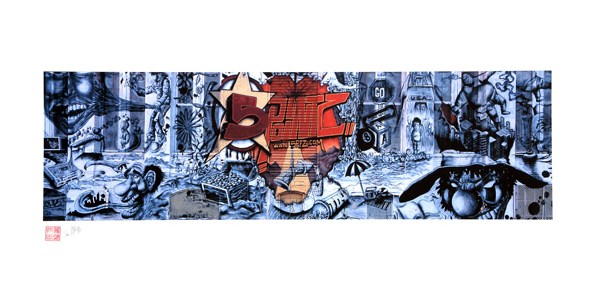

February 8 – March 3, 2018
Gallery hours: 12pm – 6pm or by appointment.
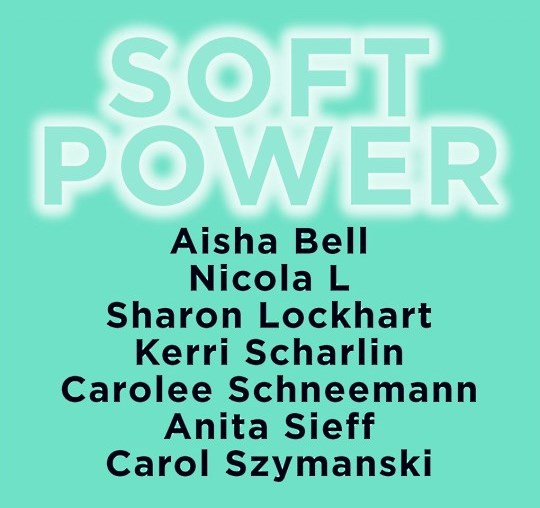
December 1, 2017 – January 27, 2018
(closed December 22 to January 9)
Gallery hours: 12pm – 6pm or by appointment.
In his 2004 publication Soft Power Joseph Nye asserts that, “Seduction is always more effective than coercion, and many values like democracy, human rights, and individual opportunities are deeply seductive.” According to Nye, soft power rests on several resources, one of them being its culture (in places where it is attractive to others), which is clearly demonstrated by artists in this exhibition. The underlying socio/political messages of seven contemporary artists in this show are visually communicated with strong concepts, and power, while presented in a poetic, symbolic and mythological way.
Aisha Bell
“De crown.” These crowns explore our shared histories as perpetrators, victims and beneficiaries of imperialism, colonialism, and fascism. A symbol for the shifting face of power dynamics, these heavy fragile and uncomfortable headpieces invite the viewer to wear the crown and metaphorically redistribute the balance of power.
This installation is part of an ongoing project to make art accessible using social media as the point of access. The artist suggests: If you would like to participate in this project, please stand underneath the crown and place it upon your head. Rise up slowly: it is heavy. Take a photo and post to Instagram with the hashtag #DEcrown (Aisha Bell, 2017)
Sharon Lockhart
In June 1997, Sharon Lockhart, Laura Owens, and Frances Stark mounted a group exhibition at Blum & Poe Gallery in LA. The three artists offered works in distinctly different media — a photograph, a painting, and a drawing; yet, through an intense, often daily conversation involving discussion and examination of each other’s work, they influenced each other in varying ways.
In the photograph by Sharon Lockhart the three artists (Lockhart, Stark, Owens, left to right) pose in sack-dresses that collectively spelled out “California Republic” from the state flag.
Facing sideways from the camera, pieced together from strips of cotton and felt, they stood, disengaged, highly bored. The conceptual spin of Lockhart’s picture, it seemed, was to turn down the charm on the very notion of the “publicity” photograph. The portrait, a very different vision of the young “LA woman artist” spawned on the pages of Harper’s Bazaar, also reads as a pointed declaration of independence by three women confronting a male-dominated, New York-centered art world.
Kerri Scharlin
“Marina Adams titled her first solo show at Salon 94 ‘Soft Power,’ a term she borrowed from political scientist Joseph Nye, which refers to a strategy of seduction over coercion. Soft power is getting others to want what you want, not by dictating, but by influencing desires. When I encounter an artist’s work for the first time, I bring to it everything I’ve seen and learned over the years. Am I seduced? Do I love it? My paintings of women artists in their studios start when I succumb to an artist’s body of work. In ‘Marina Adams in Her Studio’ the artist is shown sitting in her studio, a place of dreaming, freedom, play, creation, birth, anger, love; an enveloped world. From my studio I can imagine her in her studio, and while I can be enticed by her work, I can also commune with her in the raw, fertile warmth of her studio.” (Kerri Scharlin, 2017)
Carolee Schneemann
The work “Devour/Goya” is built upon the juxtaposition between what Schneemann terms the “ecstatic normal” of quotidian moments and atrocities. “Evanescent, fragile elements” of domesticity are contrasted with “violent, concussive, speeding fragments” of “political disasters” and “ambiguous menace." As in “Precarious,” the momentum of the visual vocabulary belies the horrific subject. The architecture of the grid and the recurring relationship of the body to social politics are present throughout the artist’s work. (Soyoung Yoon)
Like Goya, Schneemann presents a socio/political critique, softened with personal, intimate and poetic imagery.
Anita Sieff
“This is a photograph I asked my friend Ilaria d’Atri to take while I was shooting last July in Naples. The location is called ‘Solfatara.’ It is a volcano upside down: the top is underneath the earth and on the surface boiling lava holes emanate sulfur vapors. Right now the location has been sequestered due to a major incident where three people died. I wanted to represent a new beginning, a sort of portal into a new stage of humanity. I consider it a self-portrait where my power is apparently nonexistent (and my figure is the smallest curled up on the right) but through such power I create this vision of mainly powerful women presences pointing to a new era.” (Anita Sieff, 2017)
Carol Szymanski
“These prints come from a larger body of work called ‘The Redundancy Project.’ The project (an offshoot of my email project cockshut dummy) took off from a text I wrote using words, phrases, and expressions used for referring to someone being fired from a job—whether from the point of view of the one being fired or the one doing the firing. This language often registers the discomfort the subject causes, even when trying to sustain a tone of distance or indifference, or a pose of bowing to necessity, in order to mask the emotional intensity experienced not only by the person being fired but by the person firing them as well as by others in the workplace who are always affected by the firing. There always seemed to be a sort of dance around the subject, a kind of indirectness, reflecting embarrassment, humility, or alienation, as well as a certain level of secrecy or euphemism in speaking about it. Of course that was before we found ourselves with a President who found fame as the man who liked to bellow, “You’re fired!” But then he doesn’t seem to believe in soft power.” (Carol Szymanski, 2017)
Nicola L
Nicola L’s oeuvre has always included the shape of the head, and the thoughts emerging from it in the form of words. In the series of works on paper in “Soft Power,” Nicola L’s heads spit out words of destruction, war and death – one part of this series titled “Rire” (“Laughter”) is missing. The artist’s favorite expression – despite gloomy social or world politics – is as always: “Il faut rire” (“we have to laugh”). The banner “Same Skin for Everybody” refers to the artist’s series of performances with a coat for 12 people. The performers – moving under the direction of the artist – are all equal once underneath the same coat. The underlying socio/political message is always prevalent in Nicola L’s work, but it is never forceful or “in your face,” a perfect example for “Soft Power.”
The viewer physically and emotionally interacts with art, and by doing so moves art into life. When you move art into life, you move into politics.
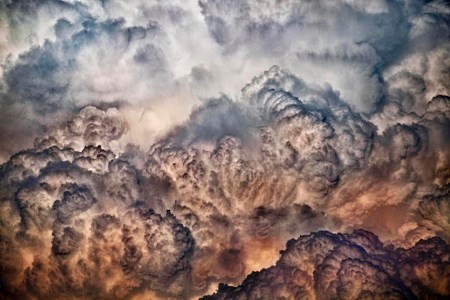
October 7 – November 18, 2017
Organized through Katharine T. Carter & Associates
Chelsea, New York City: Curator D. Dominick Lombardi’s premise for the exhibit Free Form Five is that while the five artists’ selections of subject matter, process, media and aesthetic, are very different from each other – they all make art that reveals a new and compelling depth of perception. Fixed ideas and familiar notions are eclipsed by free form innovation, as these artists leave behind just enough information to ground their content in the known.
Sandra Gottlieb’s fantastical photographs of monumental cloud formations possess surprising color and weight, much different than what we might expect at sunset. Gottlieb takes these photographs from a unique perspective, once familiar forms become more tactile and intense, a parallel view that has just the right mix of dizzying detail and frightening proximity.
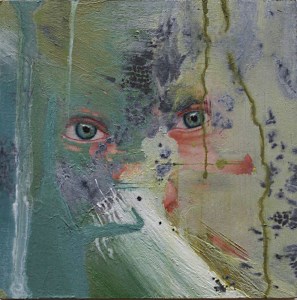
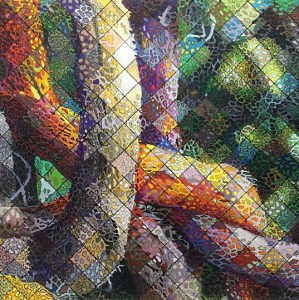 Sharon Kagan, Painting 3, 2016, mixed media, 20 x 20 in
Sharon Kagan, Painting 3, 2016, mixed media, 20 x 20 inSharon Kagan finds and expresses the complexities of the universe in a most benign place. Like a physicist explaining matter and energy, or a mystic relaying their thoughts on the forces of life and fortune, Kagan constructs her images to reveal an interconnectedness that is as much about the mysteries and movements of life sustaining elements as it on the subject of form and representation.
Bobbie Moline-Kramer most intuitively turns human emotions into an array of abstracted vignettes. Beginning with previously painted realistic portraits that bear expressive facial features, she over-paints them with an intricate vocabulary of spontaneous shapes and communicative colors, thus obliterating most of the detail. Moline-Kramer’s improvisations react to and expand upon the portraits taking us to a variety of non-linear leads and ascending levels.

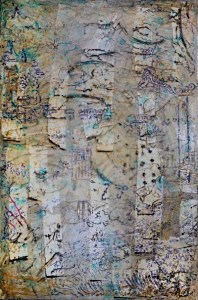 Rebeca Calderón Pittman, Lacoste, 2016, acrylic & ink on board, 54 x 32 in
Rebeca Calderón Pittman, Lacoste, 2016, acrylic & ink on board, 54 x 32 inLike a waking dream, Rebeca Calderón Pittman paintings capture enough “reality” of an interior or exterior space providing a common experience or memory, that both develops and eradicates description. As in the meanderings of daily life, we receive a sustainable amount of information to keep us in the moment as we pass through space and time to a calming illumination.
Susan Sommer sees the changing seasons and accompanying movements of animals as a constant reminder that nature is the ultimate bringer of stability and change. Instead of making accurate representations, Sommer uses cousin shapes, complementary hues and cohesive compositions, to achieve an elusive holistic harmony between form and color, and man and nature.
Exhibition management and additional information, contact Robert Curcio 646.220.2557, [email protected]
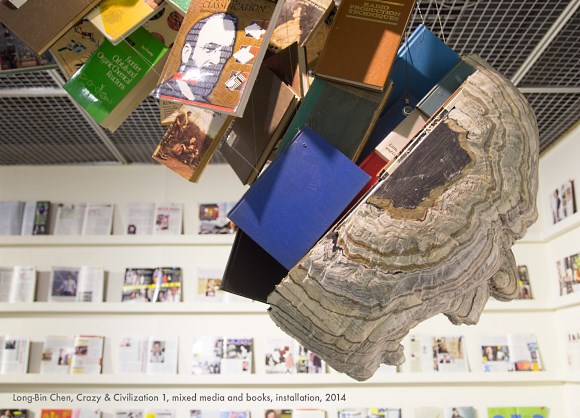
September 7 – September 30, 2017
Frederieke Taylor Gallery is pleased to present a solo exhibition of Taiwanese artist Long-Bin Chen on view at the Elga Wimmer PCC located in Chelsea at 526 W 26th Street #310.
Known for using books of every kind; phone books, catalogs, newspapers, and magazines, Long-Bin Chen creates complex, beautifully detailed sculptures of Buddha heads, Western icons such as Beethoven and Freud, human faces, warriors and animals. These creations, at first glance, resemble stone or marble. Long-Bin also creates installations of life-scale hanging figures, as well as larger-than-life heads one can walk into, made up of approximately one thousand phone books. All his sculptures and installations are made of recycled materials because the reuse of old material is an important aspect of his work.
For this exhibition, the artist has created a large scale hanging installation composed of several hundreds of books. An emotionally torn figure floats in the air followed by a trail of literary works, books and papers. This overload of information, flowing from the sculpture, represents the artist's critique of our consumerist "paper society".
Using traditional sculpting techniques, Long-Bin challenges both the cultures of his homeland and his American home to create an art based both on a reverence for the literary culture and an appreciation of contemporary sculpture. Long-Bin Chen explores different cultural meanings seeking to combine ideas and concepts from the East with those from the West and expresses what he considers a cultural conflict and problem with communication in the world.
Born in Taipei, Taiwan in 1964, Long-Bin Chen currently lives and works in New York and has exhibited widely, in the United States, Germany, Taiwan, Japan and Hong Kong. He has participated in several exhibitions at the Frederieke Taylor gallery and his work was featured at the Museum of Arts and Design in New York. Long-Bin was an artist-in-residence at MassMOCA. His work was included in the Holland Paper Biennal, and has been shown around the world in locations including the Taipei Cultural Center and the Fuller Craft Museum in Brockton, MA , and was included in the group exhibition "The Missing Piece" organized by the Dalai Lama Foundation. Most recently, his work was featured at the Everhart Museum in Scranton, PA, in an exhibition titled "Between The Covers: Altered Books In Contemporary Art". Catalogues to this exhibition are available from the gallery.
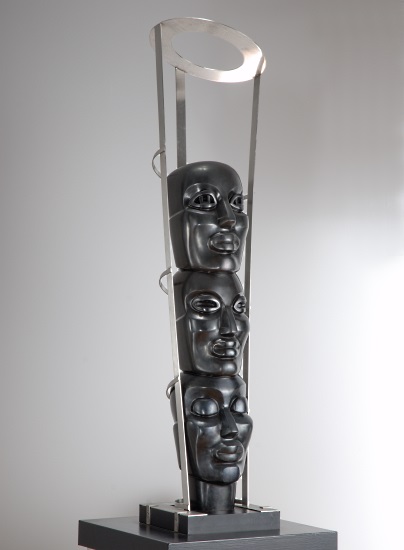
May 3 – May 27, 2017
Opening Reception Wednesday, May 3, 6-8 pm
Elga Wimmer PCC is pleased to present Strong-Cuevas’ first solo exhibition at the gallery. The exhibition will feature fourteen sculptures with eight drawings all from the 1980’s to this year.
Of her own work, Strong-Cuevas has said; “There is a meditative quality in my work – interior investigation – and I’m also fascinated by physics, cosmology, and what’s out there in the universe. The macro world, the micro world, and the material world are all part of one thing, really.”
In “Brainwaves and Archetypes, The Sculpture of Strong-Cuevas,” Donald Kuspit posits Stong-Cuevas’ sculptures as “cosmically open and epic in scale or hermetically enclosed and intimate in scale, whether constructions or cast in bronze, whether involving single or multiple heads, fuse the modernist traditions of primitivist expression and pure abstraction, confirming their originality by reconciling the opposites. They are, indeed, imaginative brainwaves of the archetypes.”
Space Totem, 1997, has three stacked mask-like heads - the lowest with eyes shut, the middle head with eyes slightly open and the top head with eyes wide open - contained in a stainless-steel frame telescoping towards an aperture that opens to the world. A metaphor for the life force contained in all of us to go further than our physical selves, to reach beyond what is essentially known.
Strong-Cuevas has had over 20 solo and 50 group exhibitions nationally and internationally. She is included in the collections of the Bruce Museum, CT; Grounds for Sculpture, NJ; Guild Hall, NY and The Heckscher Museum of Art, NY. Articles and reviews include: Architectural Digest, Newsday, New York Observer, New York Times, Sculpture Magazine and World Sculpture News.
For further information contact: Elga Wimmer PCC: 212.206.0006 [email protected] / elgawimmer.com. Robert Curcio: 646.220.2557 [email protected] / curcioprojects.com.
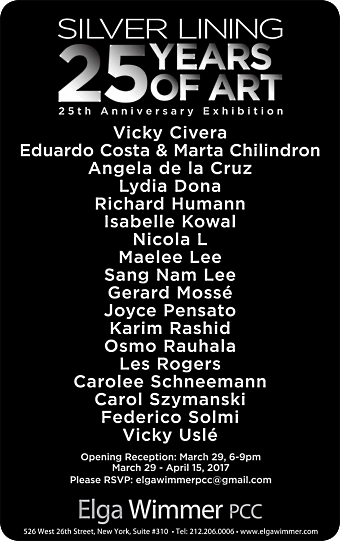
February 23 – March 18, 2017
Opening Reception: Thursday, February 23 6:00-8:00 pm
Presented by Elga Wimmer PCC and CurcioProjects
Elga Wimmer PCC in collaboration with curcioprojects present Maelee Lee’s The Next Step, a minimalistic architectural installation of high heel pumps made from white recycled paper. The high heel is at the fundamental core of Lee’s work representing it far more than a simple female icon. Through Lee’s use of photography and video, the image presents the existence of a human being.
In addition to the installation, Lee will exhibit her recent paintings in gold powder on canvas of manuscript passages from the Bible’s Genesis in Latin. This work contains her performances as a meditative attitude for seeking the genuineness of art.
This exhibit unfolds Lee’s everlasting affections for her work throughout visual diversity, but it addresses the relationship between the physical and spiritual balance, they are harmoniously juxtaposed; each quality implicates the other like the constant negotiation of void and fullness in traditional Asian philosophy.
Maelee Lee is a global artist, specializing in installation art and painting, having exhibited in Bulgaria, China, Greece, Italy, and USA, and in the 56th Venice Biennale. She was also featured twice at the Gwangju Biennale, South Korea.
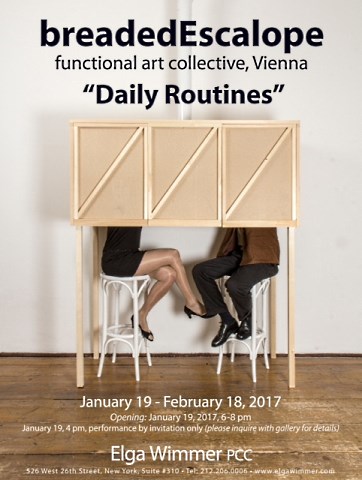
January 19 – February 18, 2017
Opening reception: Thursday, January 19; 6 – 8pm
ELGA WIMMER PCC in collaboration with curcioprojects is pleased to present the exhibition daily routines by the Vienna artist group breadedEscalope. There will be a special performance, Zen-Rug, at the gallery for 4 pm on the 19th. Due to space restrictions, to attend please RSVP [email protected].
Launched in London in 2007, the Vienna-based art and design collective breadedEscalope — Sascha Mikel, Martin Schnabl and Michael Tatschl — deals with spatial structures and subject-object relations. Analyzing and questioning daily routine are constant factors in the group's practice, and keeping everyday life in check is the point of departure for objects, installations and performances that bridge the applied and visual arts. Works by breadedEscalope are in the collections of MAK, the Hofmobiliendepot (Imperial Furniture Collection) and the Vienna Museum, and they had received the Outstanding Artist Award during their solo show at the Kunsthaus Baselland in 2014. Their last group show in New York ran until mid-January at the Austrian Cultural Forum as part of Vienna Design Week. daily routines is their 1st solo show in the US.
daily routines present a body of work addressing such themes as the perception of time, isolated consciousness, and the illusion of order, all of which depend on "social habitus." The show focuses on the habitual, the normative, the average—things that we don't give attention to, since they are anchored in daily routine. Considered self-evident, these behavioral patterns and internalized values claim the status of unquestioned reality. The objects and installations of breadedEscalope, however, play contentiously with notions of use value and consumption. The works' intense subject-object dialog opens new perspectives and a broader discourse. On the one hand, daily routines represent monotony, everyday life, activities "frozen in time"; on the other, it evokes the comforts of familiarity, competence, security, and tradition. It is in the ambivalence between these two meanings that we can find the ideal balance for a fulfilling life. This exhibition suggests conceptual niches and possibilities "between the lines." The artworks serve as a podium for interaction and exchange with the viewer.
In its dimensions, the Bar Non-Lieu is indeed referring to conventional bar furniture. Its central claim to be a non-place, however, is ultimately obtained by the opportunity to enter the furniture and thus be able to experience it as space. This shifted perspective expands the viewer's perception of the piece to an atmospheric bar with room for two people. Thereby, the Bar non-Lieu clearly focuses on interpersonal dialogue and its plain and minimal design offers the perfect setting for an intimate conversation. By closing both doors, you can create a multifunctional space of retreat. From the outside, only the legs of the guests are visible. Gestures and words, however, remain secret. The interior's design enhances the visitors' voices acoustically and you can hear yourself clearly, while exterior noise is shielded from the outside. The central bar-table provides with the ideal distance between the two dialogue partners.
In the installation Zen-Rug a merely functional component of a vacuum cleaner is translated into an aspect of a higher ritualistic order. By developing the absurd product of a glass vacuum cleaner nozzle—hand blown by artisans—breadedEscalope invents a new version of the classic device. In a performance, the artists, with the help of their specially designed vacuum cleaner, imprint a design on carpets that resembles a Zen garden. Here the desire for order and symmetry—prevalent in Zen culture—meets individualism, self-discovery. spirituality and artistic development.
Clocks largely determine our daily routine. Contrary to the usual chronometers, however, Your Clock mostly stands still. It doesn't impose a flow of time on the viewer. Instead it shows a single moment on its dial—the moment of a recent interaction with a human. The clockwork was modified in such a way that one has to pull a chain to activate the dial mechanism. The clock then "catches up" on the time that has passed since it was last activated. It thus renders otherwise timeless space both visual and auditory. Household appliances usually save time, but Your Clock instead steals time from its user. It thereby creates an intense relationship, demanding attention! Through restraint of information the user is able to "gain" a certain quality of life. Your Clock is less about the dictatorial nature of time than about "time in between," which opens up another way of measuring duration. It allows users a meta-level, giving them the possibility to decide about the passing of time!
For additional information and images contact: Elga Wimmer at 212.206.0006, [email protected] and Robert Curcio at 646.220.2557, [email protected]
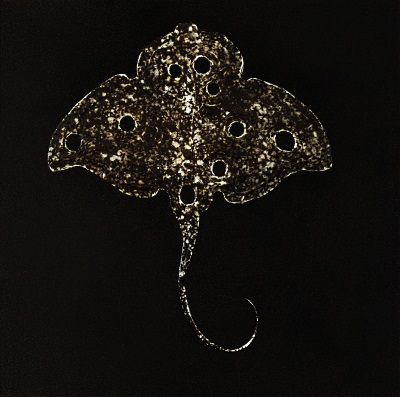
November 22 – December 22, 2016
Opening reception: Tuesday, November 22; 6 – 8pm
What is consciousness and does it exist outside of the human species? Mirror Tests or Mirror Self-Recognition Tests (MSR), study whether different animals can recognize their reflection on a mirror as themselves. If they recognize themselves, they are aware or have consciouness. Very few animals have this ability: chimpanzees, elephants and dolphins do, while dogs and horses do not. Surprisingly, Rays, the fish with wing-like fins and a remnant sting barb, express this awareness.
In his second exhibition at Elga Wimmer PCC since 2005, Mirror Test, Nordic painter Osmo Rauhala continues his convergence of art, science, and nature. The exhibit comprises two new series of paintings Forms of Silences and Garden of Atlantis, and paintings and a video on DNA which Rauhala calls “the great narrative of modern man.”
The six large paintings and collection of smaller paintings of Forms of Silences are considered to be “portraits” of various rays. Painted with a thin monochromatic background, the ray’s portrait either blends with the background or sits in stark contrast to it with bright glossy colors. In some pieces, there is a color square which Rauhala incorporates from a MSR text underlining the art and science connection to the image of the animal.
In the paintings, Garden of Atlantis, all of life is surrounded by water as if seen in a dream. The paintings are more poetic and visionary being loosely drawn from the myth of the city of Atlantis, rather than scientific concepts as in the other pieces.
The video, Book of Life, 2012, and the series of paintings entitled The Guardians of The Word, delve into Rauhala’s concerns over DNA. While we know the alphabet of life – TCGA – we cannot comprehend the narrative. If we cannot fully understand the narrative, then there is the potential of mutations. This is why the letters of DNA in the video and paintings are caught falling like snowflakes chaotically entwining and crossing. Rauhala sees the moths (nature) resembling knights with spears as guardians of DNA (the word).
In an interview from 2013, Rauhala explained his views - “Life is complex and full of mysteries and we should be humble in front of it. Art is one tool on our way to understand the world around us, as well as science, philosophy and religionBorn on a small organic farm, Rauhala continues a 14 generations long test about natural phenomena.
Osmo Rauhala lives between Finland and NYC. Since 1990 he has embarked on a series of video installations. In 2017, he will have a solo exhibit at the Didrichsen Museum; Helsinki, Finland. He has over 50 solo exhibits in Germany, Netherlands, France, USA, Canada, Brazil and the Scandinavian countries. Rauhala has had 15 solo museum exhibitions including Groningen Museum, Netherlands; Museum of Modern Art, Rio de Janeiro; Stadtmuseum Ratingen, Germany; and the Museum of Contemporary Art Millesgarden Stockholm, Sweden; Kiasma - Museum of Contemporary Art at the Finish National Gallery, Finland.
Hours: Tuesday through Saturday, noon to 6pm. For information contact: Elga Wimmer at 212.206.0006, [email protected] and Robert Curcio at 646.220.2557, [email protected].
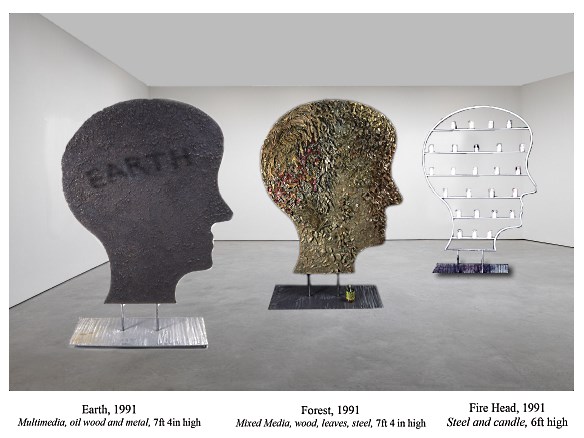
September 15 – October 15, 2016
Opening Reception September 15, 6-8 pm
Elga Wimmer PCC in association with curcioprojects, is pleased to present a solo exhibition of Nicola L - Nicola L and The New Millennium; The Head, LaTête, La Cabeza, Il Capo, Der Kopf. A long day’s journey to the end of the skin. The exhibit features three of Nicola L's signature heads from 1991: Earth, Forest and Fire Head, a set of early paintings around the same theme, with three sets of Giant Penetrables from 2002 and 2012.
July 1 – August 5, 2016
Opening Reception: Thursday, June 30 - 6 to 8 pm
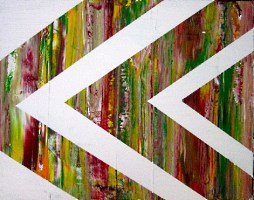 Atlanta Japp Untitled, 2016 |
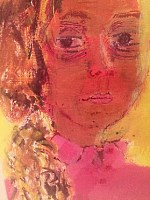 Willa Schwabsky Self Portrait, 2010 |
 Charlotte Fox Plaything, 2015 |
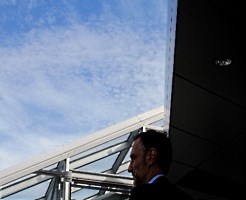 Kathryn McLane The Man of Lyon, 2016 |
Part of what has intrigued generations of readers about the poetry of Arthur Rimbaud is that he'd written all his great works by the time he was 21 – time will tell with this group of exciting emerging artists! There is a special raw quality to this work where the elements of their time and their age come in to play. It is a fun and engaging group exhibit of great diversity, including painting, drawing, collage, sculpture, photography, and video, with works gathered from around the U.S., Europe, and Latin America, giving a wide-ranging snapshot on early talent in all its freshness before it is manipulated for better or worse by teachers and the market.
Speaking of Rimbaud, Daniel Mendelsohn in The New Yorker wrote, "The sixteen-year- old went on to make an assertion that Graham Robb, in his idiosyncratic yet magisterial 2001 biography, refers to as the 'poetic E=mc2': 'Je est un autre' ('I is someone else'). His insight, plain perhaps to us in our post-Freudian age but startling in its time, was that the subjective 'I' was a construct, a useful fiction—something he'd deduced from the fact that the mind could observe itself at work, which suggested to him that consciousness itself, far from being straightforward, was faceted. ('I am present at the hatching of my thought.') He suddenly saw that the true subject of a new poetry couldn't be the usual things—landscapes, flowers, pretty girls, sunsets—but, rather, the way those things are refracted through one's own unique mind. 'The first study of the man who wishes to be a poet is complete knowledge of himself,' he wrote in the letter to Demeny. 'He searches his mind, inspects it, tries it out and learns to use it.'"
Thanks to Rush Arts, Willa Schwabsky, Atlanta Japp and Kathryn McLane for their introductions of fellow artists and support of this exhibit!
Gallery Summer Hours: Tuesday through Friday, noon to 6pm. For information contact: Elga Wimmer at 212.206.0006, [email protected] and Robert Curcio at 646.220.2557, [email protected].
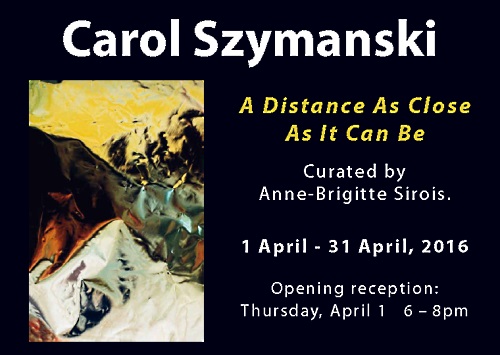
April 1 – April 31, 2016
Elga Wimmer PCC is proud to present its fourth solo exhibition of works by Carol Szymanski. The exhibition has been curated by Anne-Brigitte Sirois.
The Cibachrome photographs presented in this exhibition are offshoots of Szymanski’s 2015 sculpture series solfege inflatables and her 2015 painting series Icons: light reflections of the paintings’ colors bouncing off the Mylar silver surfaces of the sculpture. With these abstract yet accurate and unmanipulated images, Szymanski expands the language of her perceptual communication paradigm while deepening her conceptual investigation of Arnold Schönberg’s 12-tone serialism and Walter Benjamin’s concept of aura, "a strange weave of space and time, the unique appearance of a distance as close as it can be."
The exhibition also includes a text work derived from Szymanski’s decade-long cockshut dummy email series. Here, parallel points of views and connecting perspectives converge allegorically through elusive sensorial feelings in various metaphorical situations:
Then
as to titillating the visual nature. A hand was raised in the audience, "Can you speak to the visual aspect of metaphor from your titled position as professor of philosophy of art, not aesthetics as you carefully denied earlier but pronounced instead your obedience to philosophy of art as a more clear definition of yourself?"
"The visual, I have nothing to say about as to its regards to metaphor because metaphor refers only to language."
OH
the mere making thus becomes metaphor for its own sake for if there is no metaphor in the visual as opposed to in the lingual then art merely postures itself in some identity theory or other."
Carol Szymanski is an internationally exhibited artist who has been the recipient of the Rome Prize and a National Endowment for the Arts fellowship, among others. She will launch Lost Contact With 12 Sentiments, a new work in the form of an instagram and an email, as a successor to the cockshut dummy on May 1, 2016. Please view on Instagram @cockshutdummy or request email instruction.
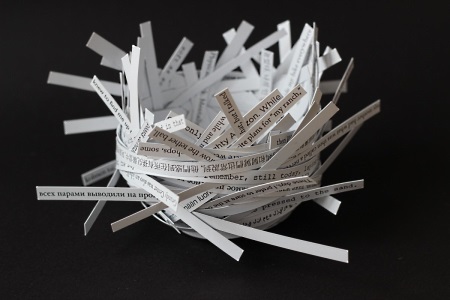
February 25 – March 24, 2016
Elga Wimmer PCC in collaboration with LuxArt, Taipei, is proud to present the work of New York artist, Richard Humann, and Paris based artist, Triny Prada. Both artists, though different in their approach and realization of their work, have themes of water and light prevalent throughout them.
Richard Humann will be exhibiting his large-scale sculptural installation, The Same River Twice along with smaller sculptures and drawings. In The Same River Twice Humann presents a 32 foot long recreation of the Hudson River, but instead of the river being filled with water, it’s filled instead with thousands of cut up words of ink on paper from books and writings that inspired him to move to New York City many years ago from his hometown in the Hudson Valley. For his sculptural bird nests, he has asked people from all over the world to send stories of their youth to him, written in their native language. Humann then took the texts and wove them into bird nests. The work is entitled, The Songbird Sings of Home and will be presented throughout the gallery on sculptural copper branches. Other work includes a series of drawings of graphite on paper, and an edition from his series, Artist Statement.
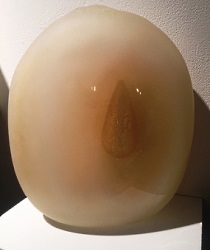
Richard Humann was included in the 2003 Venice Biennial, has exhibited in international museums such as the Gabarron Foundation in Murcia, Spain, the Tampere Art Museum, Tampere, Finland, and the Daelim Contemporary Art Museum, Seoul, Korea. Humann is a recent recipient of the Pollock-Krasner grant.
Triny Prada combines light and water in her installation, comprised of Murano glass and gold sculpture, and a new series of paintings made with thread, gold powder, gauze, 22 carat gold leaf, and vinyl paint. The glass sculptures presented at the last Biennial in Venice, titled Invisible Powers, were made 2015 in Murano.
The translucency of this work with a drop shaped cell in the center, recalls the body and the cell, which is reminiscent of early Kiki Smith glass sculptures referring to body parts. In this case, however, it is the inside of the body, the part we normally cannot see. The creation of this vessel from liquid white-hot glass symbolically gives life to a new cell, a renewal, a new life.
Her series of new paintings in this show is titled Dialogues de Lucioles (Dialog of Fireflies). The artist states: "Through my paintings I bring you to seeing the phosphorences that bathe in the depths in which we are submerged, and that navigate along our cellular chains. In this way, each one of us, in taking in this experience, like a silent conversation, returns to one’s own depths and uncovers the incandescences of one’ most intimate state."
Triny Prada is an artist, born in Columbia, now working and living in Paris, France. She has participated, among others, at the Biennale in Venice in Palazzo Bambo in 2013 and 2015, and in 2014 at the Polytechnic Museum in Moscow, Russia.
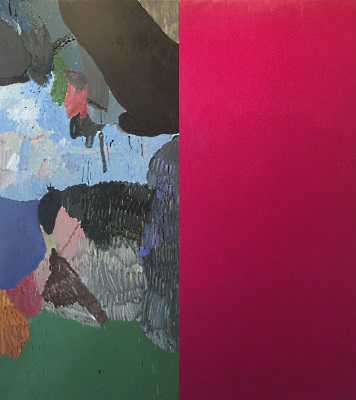
November 21, 2015 – January 31, 2016
Elga Wimmer PCC, in association with curcioprojects, is pleased to present Les Rogers' solo exhibition of recent paintings entitled Just Married. This will be Rogers' first solo exhibition with the gallery; he previously exhibited in the gallery's summer group show A Midsummer Night’s Dream.
When Rogers began his new paintings on mass produced wood doors (referencing De Kooning’s use of doors for his Women series, 1964/65) this past summer, he saw them as singles, without the intention of bringing them together as a diptych. Then in early fall when he placed the singles together as two, he recognized a connection between them as "couples"- either by being argumentative or by finding common ground they helped define and reveal each other. Recently some of the paintings remain "single", but for many of the new "couples" they are "just married".
Bob Nickas, critic and curator, wrote of Rogers’ approach to painting – "Rogers has a tendency to de-stabilize pictorial space. This intentional undermining of a picture gives it a tension and, at the same time, a (dis) equilibrium it would not otherwise have had. His intuitive, spontaneous approach is followed by a slower, deliberate activity – adding, subtracting, canceling out." While Rogers continues to de-stabilize and undermine his paintings through his layers upon layers of veils of watery colorful depth asserting themselves against concentrated solid formations, drips, daps, and splashes, he creates an immediacy found in Abstract Expressionism and a fluidity of action with a definitive brushstroke. These direct and palpably "just made" panels are then brought together to create something altogether new—capturing a moment —the start of a new life together.
Les Rogers lives and works in New Jersey and graduated from the Rhode Island School of Design in 1989 with a BFA. Rogers will have a solo exhibit at Mier Gallery in Los Angeles next year and has had among others solo exhibitions at Galerie Suzanne Tarasieve, Paris; Leo Koenig Inc, Half Gallery, NYC; The Happy Lion, LA; Galerie Christina Wilson, Copenhagen; Galerie Michael Janssen, Cologne., Karlheinz Meyer, Karlsruhe.His work is in important private collections as Jerry Speyer, the Hall Art Foundation as well as Susan and Michael Hort Collection in New York, Elton John, UK, and among others in corporate collections as Bosch—Berlin and Prince Tabacco- Copenhagen.
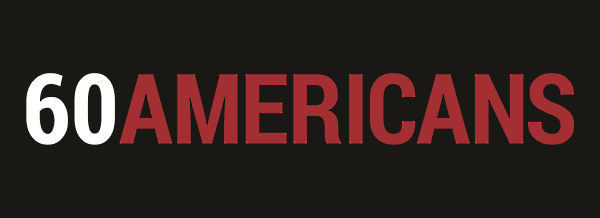
May 21 – June 14, 2015
Opening Reception: Thursday, May 21 6:00-9:00 pm
Performance by: Hayoon Jay Lee @ 7:30 pm
60 Americans is a response to the ill-gotten gains of flipper based collectors, money corrupted and trend obsessed gallerists, shopping mall (puppy mill/factory) inspired art fairs, nepotism and favoritism of the made men and women of fast track MFA programs in America. This exhibition will offer an alternative perspective on what's arguably relevant and important in the current landscape of American contemporary art.
February 13, 2015 – March 28, 2015
Performance: March 5, 7pm; RSVP required
Chelsea, NYC: Elga Wimmer PCC, in association with curcioprojects, is pleased to present French-born and NYC-based, Nicola L.’s Atmosphere in White. Presented at last year’s Biennial of Liverpool, curated by Anthony Huberman, Atmosphere in White spans five decades of functional objects and furniture, and conceptual sculptures. Gary Indiana, critic and writer, observes that, "Nicola lives in a human universe, a world constructed by humans, and her work reclaims this humanity by reminding us at every point that our constructions emanate from within the envelope of flesh we inhabit."
Fragments of the body: a foot, an eye, a head, and a torso are transformed into a sofa, standing lamp, bookcase, and ironing board. A large white vinyl Sofa Foot, 1968-2013, and a round plastic Eye Lamp, 1969-2013, evoking a planet, represent the Pop era in visual as well as material aspects. The Library Head, 1979-2012, is a bookcase in the shape of a large wooden head where new and old information moves in, around, out and back in, creating an exchange both private and public. With a wink to Duchamp’s "IL FAUT UTILISER LA JOCONDE COMME UNE PLANCHE A REPASSER" Nicola L.’s Woman Ironing Table, 2006, accentuates the duality of the sensual side of a woman with what is stereotyped as women’s work.
Nicola L.’s series of Penetrables are soft sculptures where the viewer’s body and the sculpture embody each other. Suspended from the ceiling, Atmosphere in White, 2005, the viewer "wears" it as a new layer of skin by entering your arms, legs, torso and head into the sculpture. Antartica, 2014, a white vinyl wall hanging with industrial looking gloves and a mask for the head which when worn references the frozen landscape. Pierre Restany, art critic and cultural philosopher, described the Penetrables as "the same skin for everybody."
Penetrables performances, like White Cape on March 5, have been staged since the early 70’s on the streets of Paris, Brussels, Cologne, Barcelona and the Great Wall of China where many coats form one large coat simultaneously worn by performers. White Cape is a large white vinyl coat constructed of four coats, each of the four performers holds a mask with the name and photograph of one of the Beatles as they move through and out of the space to the song "Help!" A merger of contemporary thoughts on the body/skin with the sensibility of 60’s era POP free style.
Nicola L. will be participating in the Tate Modern’s upcoming The World Goes Pop, curated by Jessica Morgan presently director at DIA Foundation, NYC. Currently she is in the EXQUISITE CORPUS curated by Cora Fischer at SECCA, North Carolina. She was included in ARTEVIDA : politica / corpo, Museu de Arte Moderna and Casa Franca in Brazil. Nicola L. has widely exhibited, had film screenings and performed throughout Europe, Cuba and South America, and the US.
For further information contact: Elga Wimmer PCC: 212.206.0006 [email protected] / elgawimmer.com. Robert Curcio: 646.220.2557 [email protected] / curcioprojects.com.
December 3, 2014 – January 24, 2015

J.J. L’Heureux, Ross Ice Shelf 1, 2014, photograph, 32"x144"
New York, NY: Resonance and Memory: The Essence of Landscape is a group exhibition organized by Katharine T. Carter & Associates, hosted by Elga Wimmer PCC, curated and managed by Robert Curcio of curcioprojects. Each of these artists, in his or her own unique way, commemorates the profoundly mysterious, elusive, and imaginary qualities of landscape.
Kathleen Elliot’s (CA) flameworked glassworks arose from her great love of plants, their life cycles and the beauty of all their parts – the spiritual connection she feels with nature in her own imagined Garden of Eden. Sandra Gottlieb (NYC) shapes perception, time and place in her sensual ocean images photographed at Rockaway Beach, Queens. In her sixth series, October Waves, she deals with the pure essence of each wave; the dramaturgy of the wave; its strength and strum and drang. J.J. L’Heureux (CA) has provided us with an image of a tiny portion of the Ross Ice Shelf... the face we see is 50-150 meters high and extends for 800 kilometers; in its entirety, it is the size of France. Overwhelming and awesome in its silent majesty, it remains fragile and ever changing.
John Lyon Paul’s (NY) sculptural devices reference abstract, organic and geological forms, suggesting the burden of human suffering and hope. True to their material origins, he creates a deep connection to the fragile world that we inhabit. In Rebeca Calderón Pittman’s (OH) recombinant drawings, reality becomes transparent; places that are ordinarily distinct become part of a single, flowing image space; her delicate layered drawings are dominated by the emptiness that pervades them.
Gerry Tuten’s (PA) work investigates the relations between gestural abstraction, and her ongoing interest in nature, often illuminating the site she is rendering. Of an ephemeral nature, her paintings describe the intangible qualities of water and forest. Gail Watkins (MD) combines paint with organic substances (sand, stone, and glass), often mistaken for a geological sample; creating an intimacy between the viewer and work that is at once primitive, spontaneous, and powerful. Martin Weinstein (NYC) creates paintings on 3-5 sheets of plexiglass layered together to form an image of illusionistic depth; he interprets this special theatre by depicting the same scene multiple times, and by inserting discontinuous elements... a reminder of the tenuous nature of reality itself.
For further information contact: Katharine T. Carter, Katharine T. Carter & Associates: 212.533.9530, [email protected] / www.ktcassoc.com. Robert Curcio: [email protected]; 646.220.2557.
December 5, 2013 – January 25, 2014
Ulla Enevoldsen likens the abundance and longevity of nature to humanity composing her works out of hand-made paper sometimes combining it with other materials like metal, stone, or even optic fibers. Consequently in her Human Snow Crystal, appears a human form juxtaposed upon a cut out of a snowflake. Enevoldsen works with other celestial phenomena as well orbs that can be read as galaxies, the moon, sun or planets. Moreover, she creates interactive sculptures such as Sea Gobble and Wave that come alive as the viewer approaches. At times they emit repetitive ocean wave sounds while simultaneously responding to light. With her constantly changing sculptures Enevoldsen overcomes stativity, creating dynamic pieces that interact with the viewer. Enevoldsen’s installations although beautiful and subtle in coloration, contain a critical twist that is evident in such orb pieces as Ice and Stone, Ice Holes, and in Ice Sandseen in their deteriorating aspects. Ice and Stone’s cool grayish/turquoise colors and pock marked surface are reminiscent of a moonscape while Ice Holes emits a feeling of coldness and melting ice in its blueness, and Ice Sand is much like a burning dessert.
Vibeke Fuglsang-Damgaard is environmentally aware with a focus on water energy from which everything flows. Her interest in water flows with that of the writer Austrian Viktor Schauberger whose works inspired her. He wrote of water reaching its highest density at four degrees, that it gains energy in curves and spirals, creating enough counter-streaming for trout to jump upward in a river. In her statement, Fuglsang-Damgaard points out that we live in water (amniotic fluid) before we are born. In her installation, a leaking faucet is attached to a pink cardboard box instead of a natural source. Furthermore, the box is open, as it ostensibly appears, the water has been depleted. In another area of the installation water is spilling out of an open blue box while nearby aquatic life forms appear to be swimming downstream. Visible upon closer examination these fish shaped forms contain hooks with fishing flies that necessitate we read them critically. Similarly, in the same installation is a heart-shaped area comprised of black daggers with blue water drops painted on them. What becomes obvious is that Fuglsang-Damgaard is an artist dedicated to the continuity of life creating her works from recycled materials so as to contribute to its survival. All of the works in this show formulate a holistic message about the world’s survival and the abuses perpetrated by humanity on the natural habitat.

June 19 – July 31, 2013
Artists have always been challenged by creating works on a very large surface, be they ceiling paintings, murals, graffiti, or projections of video or film. The artists in this show (Lydia Dona, James T. Greco, Richard Humann, Nicola L, Gerard Mossé,and Osmo Rauhala) have each created a large new work, or contributed one from an earlier series.
Bigger is not necessarily better, but in this case the viewer can be the judge, interpreting and enjoying the impressive over-sized work in this show titled XXL.
The Art Market MA program at FIT is pleased to present Don't Feed the Animals, a group show featuring works by contemporary artists who transgress social norms to reveal the ways people respond to actions performed out of context. Working in a variety of mediums, the artists shock, amuse and satirize social behaviors by setting up absurd or outlandish situations to provoke viewers into questioning personal standards and the accepted rules of society.
In videos and stills of performances, several of the artists in Don't Feed the Animals make themselves intimately available to strangers: Nate Hill – dressed in a dolphin mascot costume – offers to let subway riders bounce on his lap, while Sean Fader invites people to make a wish by stroking his chest hair. Antonia Wright and Ruben Millares engage in a prolonged public kissing session while riding up and down a busy escalator, and Yolanda Dominguez criticizes the farcicality of the fashion industry in her videos, which show everyday women, who strike model poses in crowded public spaces that make themlook rather absurd and cause concern from people walking by.
Don't Feed the Animals is organized by FIT Art Market students, Class of 2013, School of Graduate Studies. In their second year, students take a two-semester practicum in which they organize, curate, and promote a group exhibition. They graduate from the program with the knowledge, skills, and experience needed for professional careers in the art market. The 2013 curators are Lisbet Krogslund Bertelsen, Rose Frisenda, Elizabeth Landau, Vivian Lee, Anna Matos, Kathleen Mulvey, Marcela Nascimento, and Kara Romano.
A fully illustrated catalogue will accompany the show. For further information, please contact [email protected].
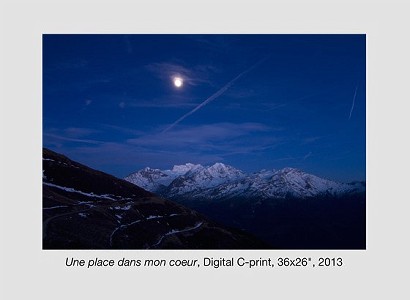
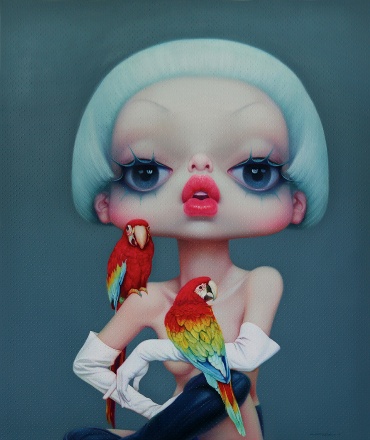
Wang paints young girls in alluring stylized poses in fashionable clothing that in their pouting manner totally win our hearts. They invite us through their sexy demeanor and colorful attire to share their constructed spectacle. They are a cross between fashion models and Barbie dolls with porcelain skin. Their huge eyes, reminiscent of 1960s Keane figures, are heavily made up with long eyelashes, plucked eyebrows, and pouting lips in red lipstick. It can be said that Wang is stereotyping the fashionable consumerist modern female, but in reality he's engaging in tongue and cheek humor. Girl #5, #6, 7 and 11 are dressed in military uniform perhaps as an excuse to juxtapose the soft femininity of their painted faces against the rough army garb. Or, perhaps as a way of punning military dress that has become appropriated by the fashion industry today. Perhaps even to compare the sameness of this fashion icon repeated over and over in different costumes, with that of troops. But, though her morphology is similar, her moods, makeup and dress change to produce lively sexy females aware of their own power. These girls are not afraid and they're not objectified females because they're not vulnerable. They invite and warn us at the same time as seen in Girl #4 who holds a gun in her left hand while a parrot sits on her right arm. Girl #6 wears a red army hat and carries a pink backpack while smoking a cigarette. She turns away from us protecting her nude right breast with her left hand, all while she looks behind her. This is not an innocent little girl but rather a dangerous siren that Wang depicts. The devil wears Prada in Girl #9 who is highly made up, with bleached white hair and, except for a pearl drop earring and a purple pocketbook that conceal her body, is nude. This is not a vulnerable creature available to the male gaze but rather one who warns us through her demeanor-- crossed arms over the chest and head turned to stare at the viewer.
Wang's fashionable females are reminiscent of the 8th Century Chinese master Zhou Fang's many depictions of women as models of ideal feminine deportment as seen in his scroll Ladies Wearing Flowers in their Hair. Indeed it was very common during the Tang Period to create ideal female models in art because real women were forbidden to appear in public. A similar situation took place in ancient Classical Greece. Rather than paint individual personalities artists painted, women's roles. And as seen in both Fang's, and Wang's paintings, women have been rendered with meticulous detail in their wardrobe and make-up. The ancient models of deportment have now become fashionable femme-fatales.
“Rainbo Conversation” - Béatrice Cussol | ||||
“Madonna and the Milky Way” - Isabelle Gros-Kowall | ||||
Curated by Elga Wimmer: | ||||
Streetwise at CAM | ||||
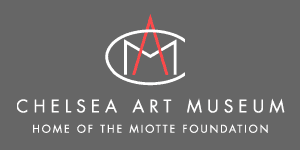 |
 |
| Marta Ares & Susana
Barbará. B.A. Ches, 2008. Duration: 2 minutes |
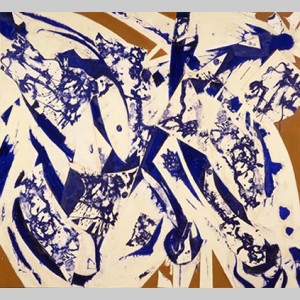 |
| Lee Krasner Download PDF about show |